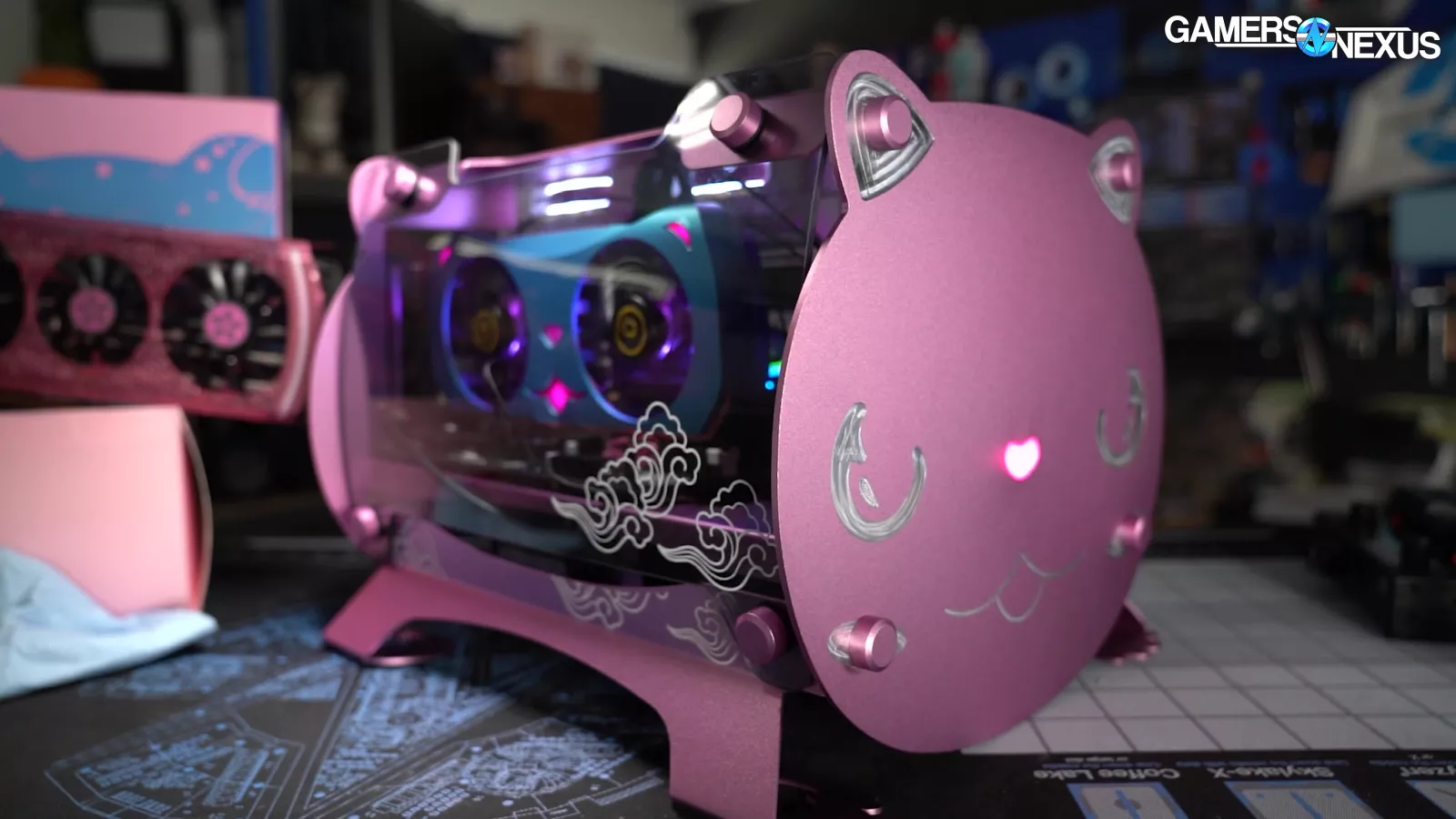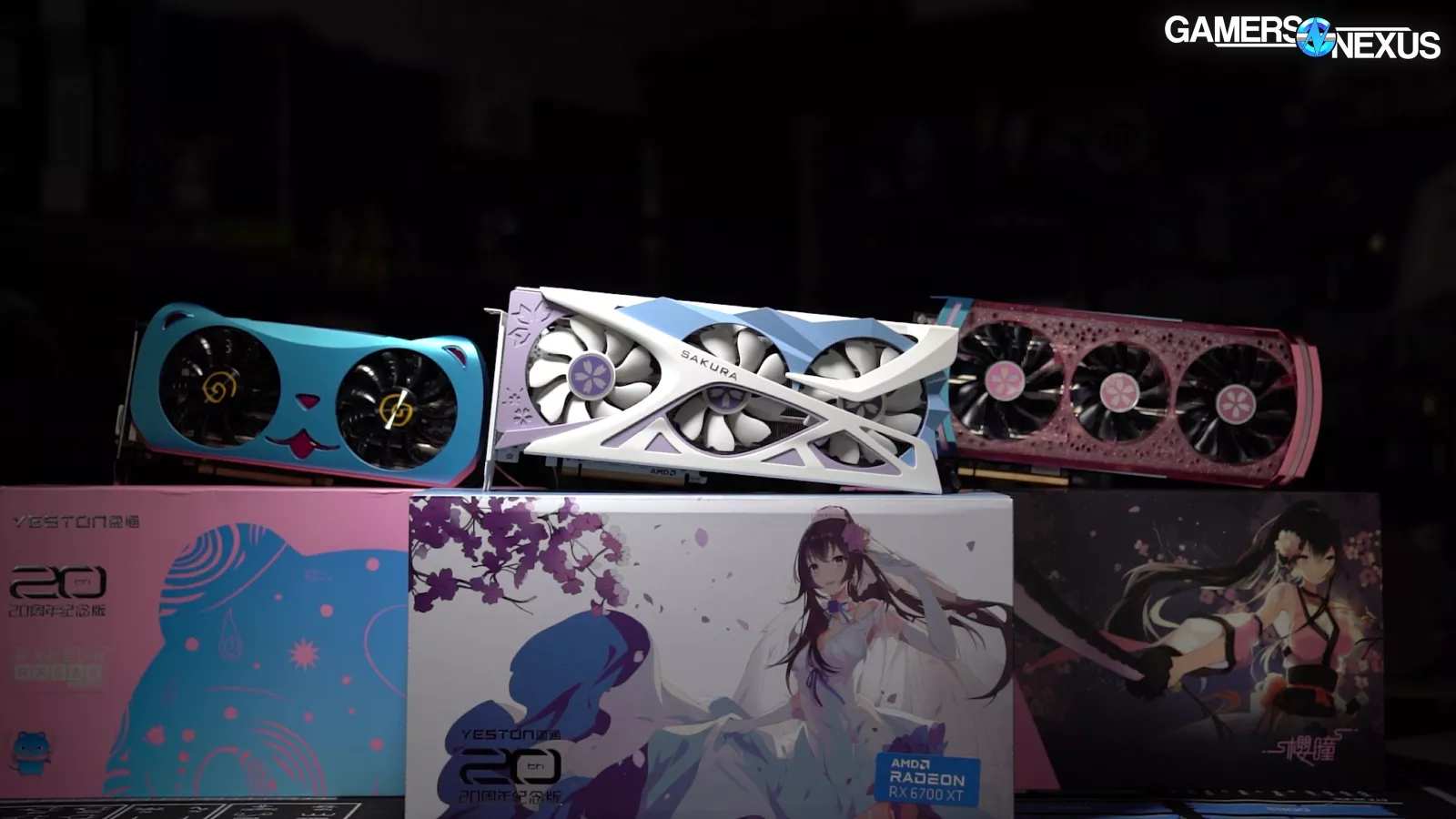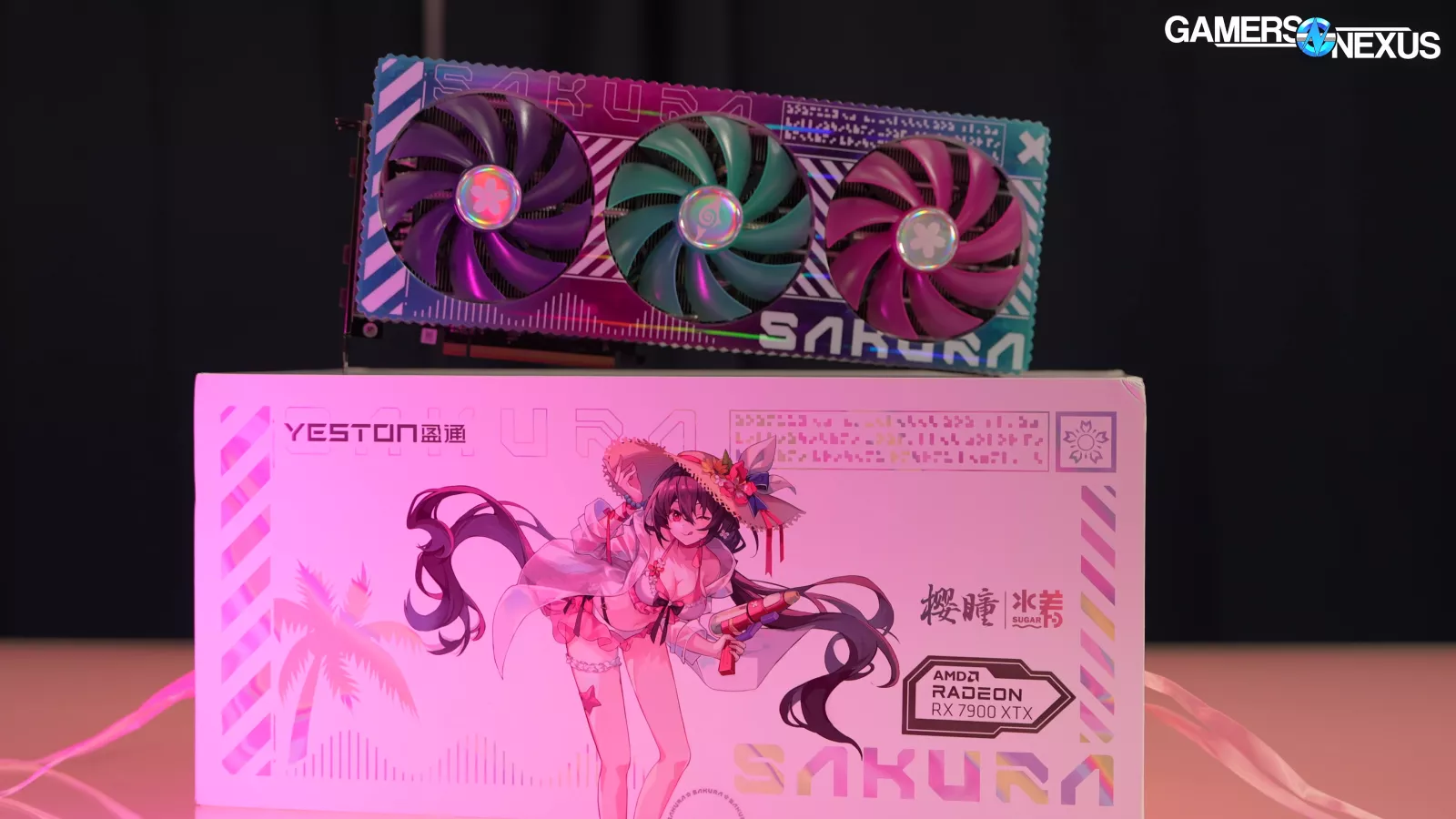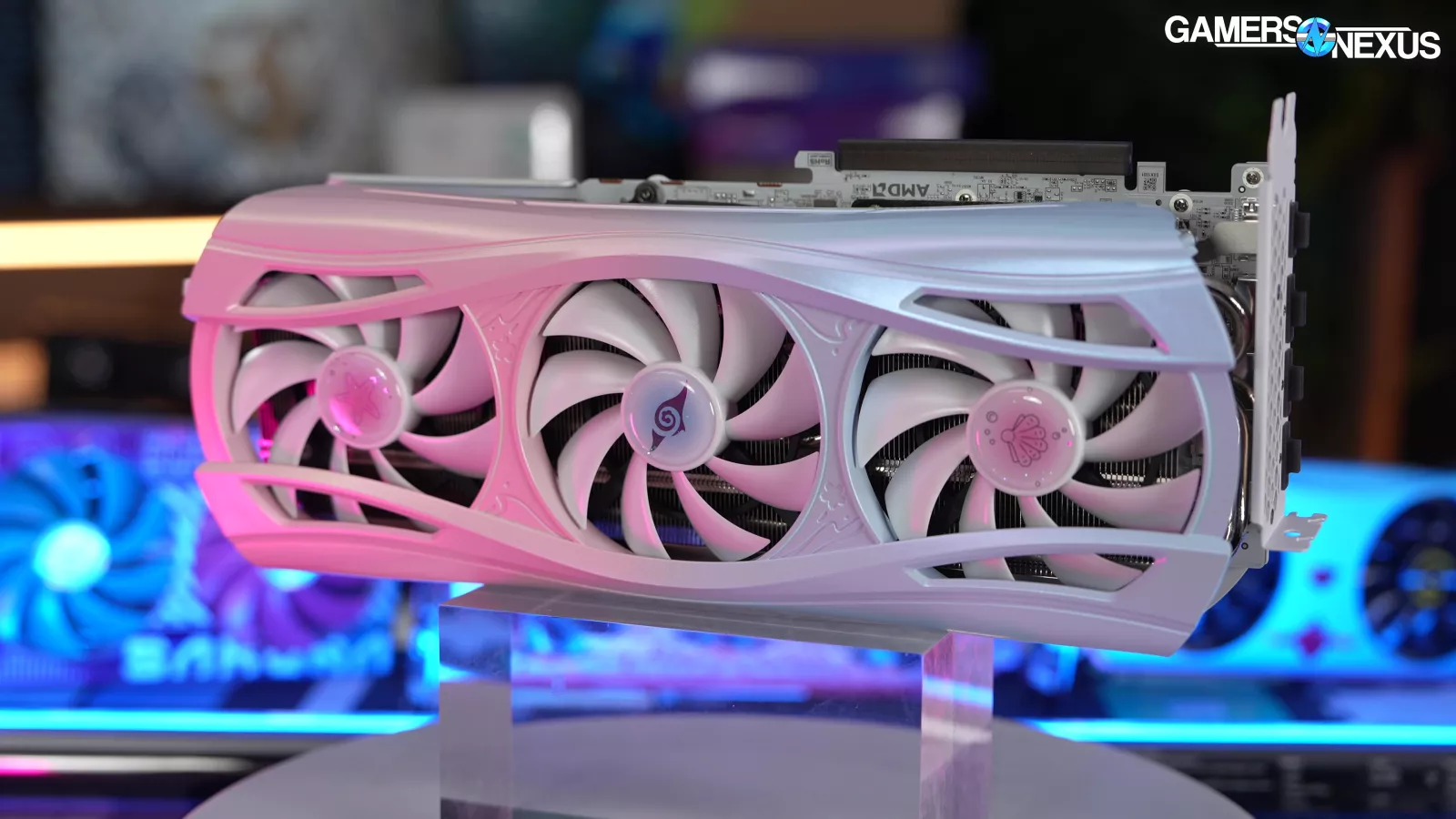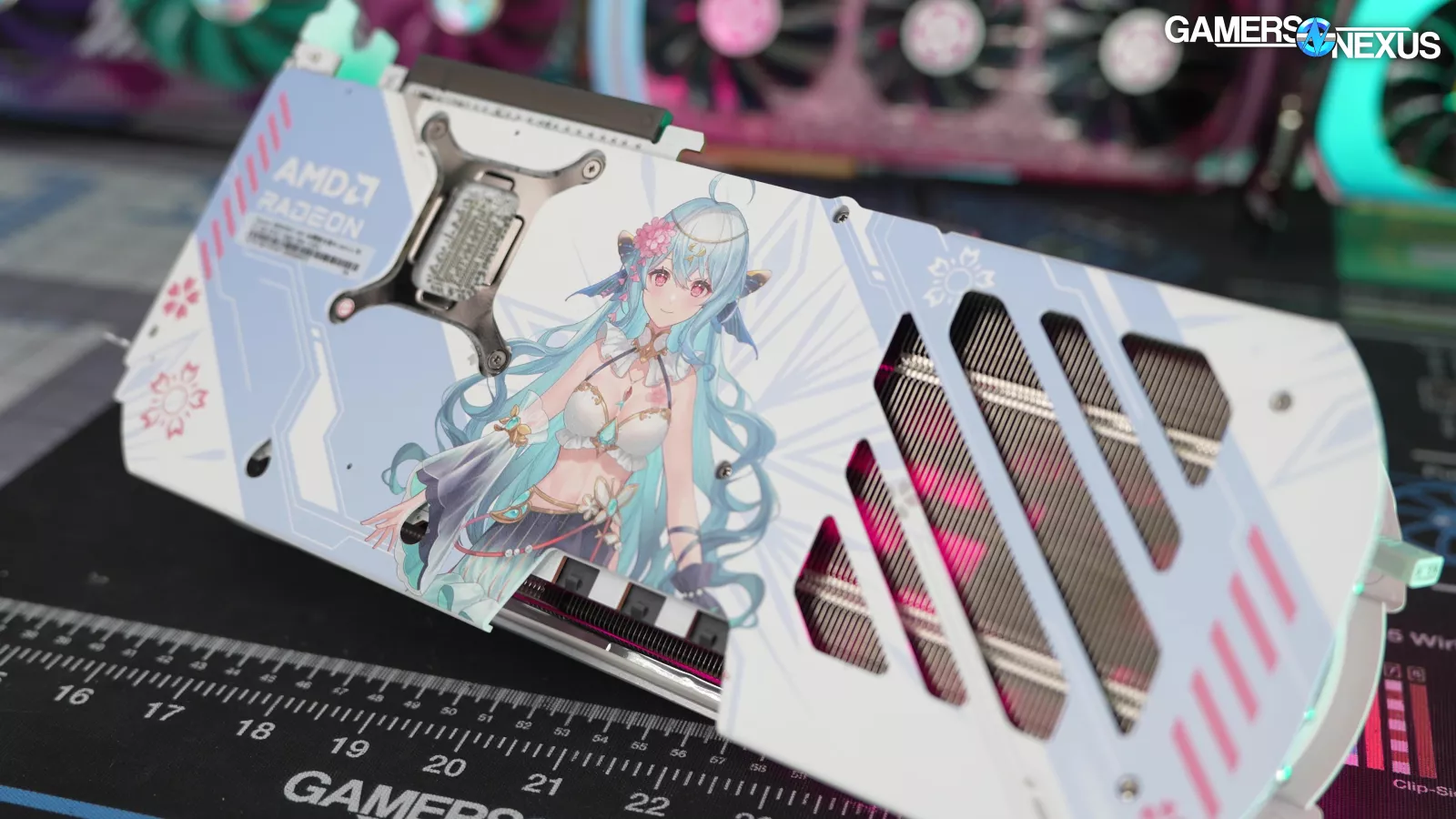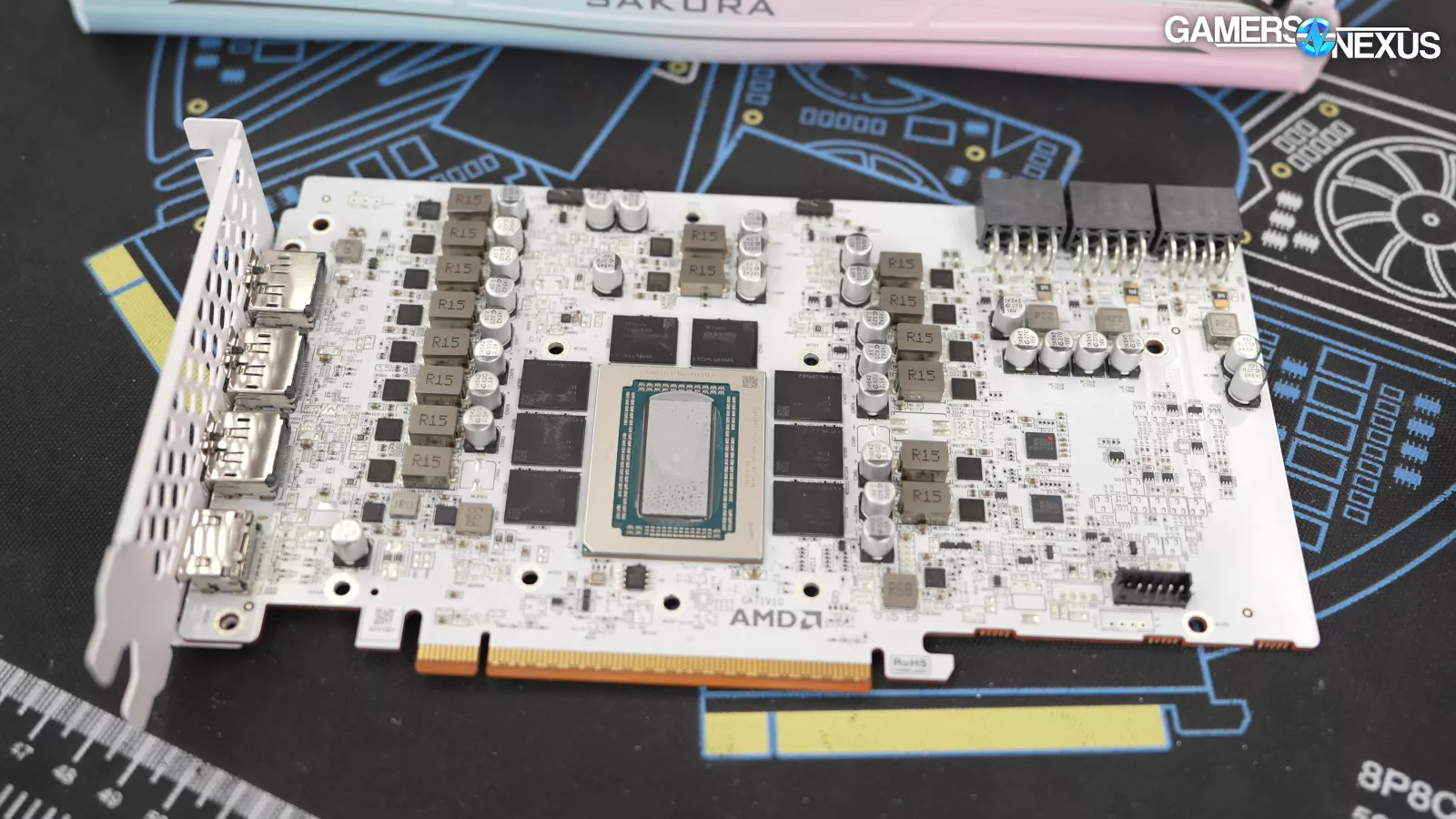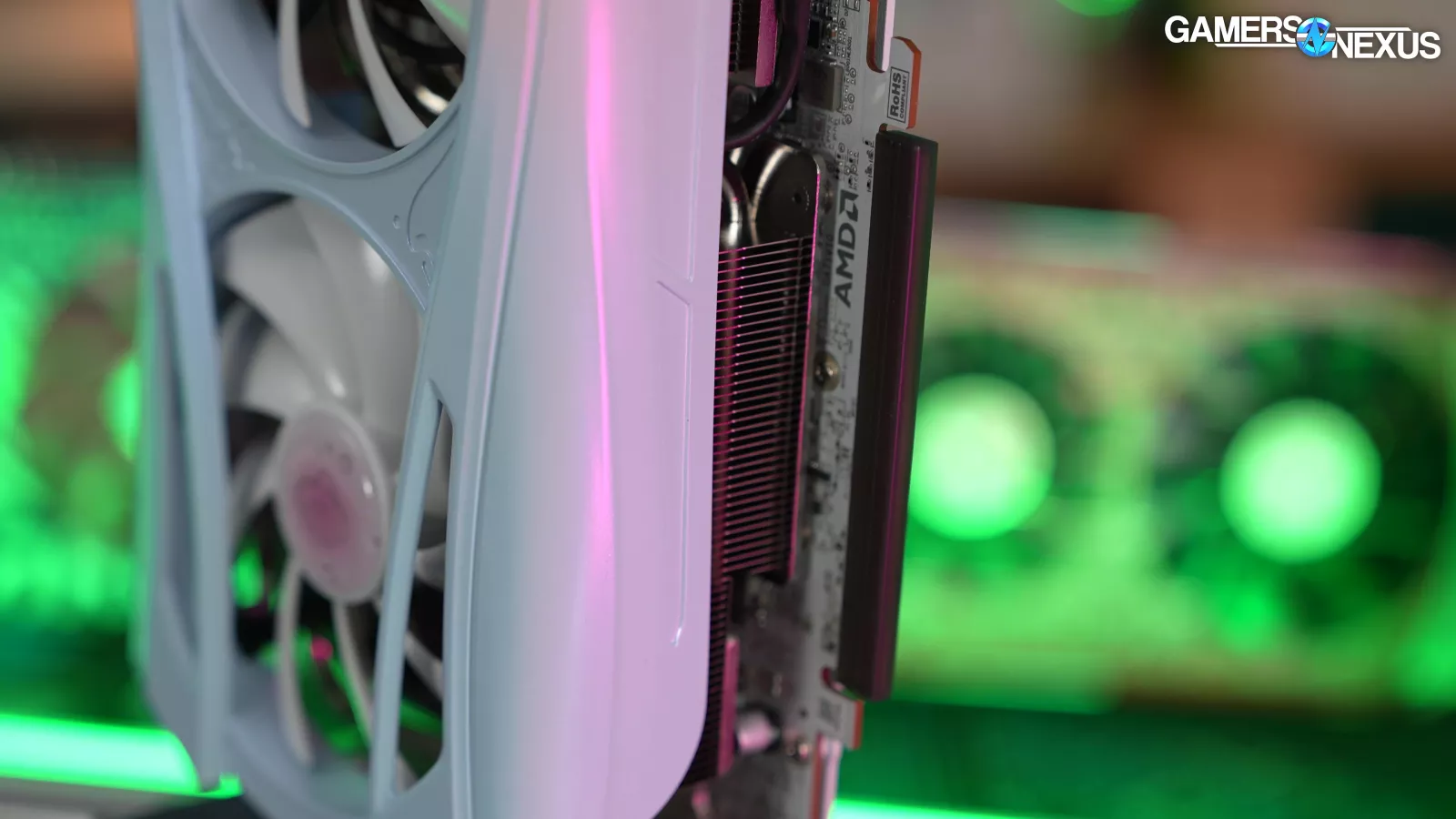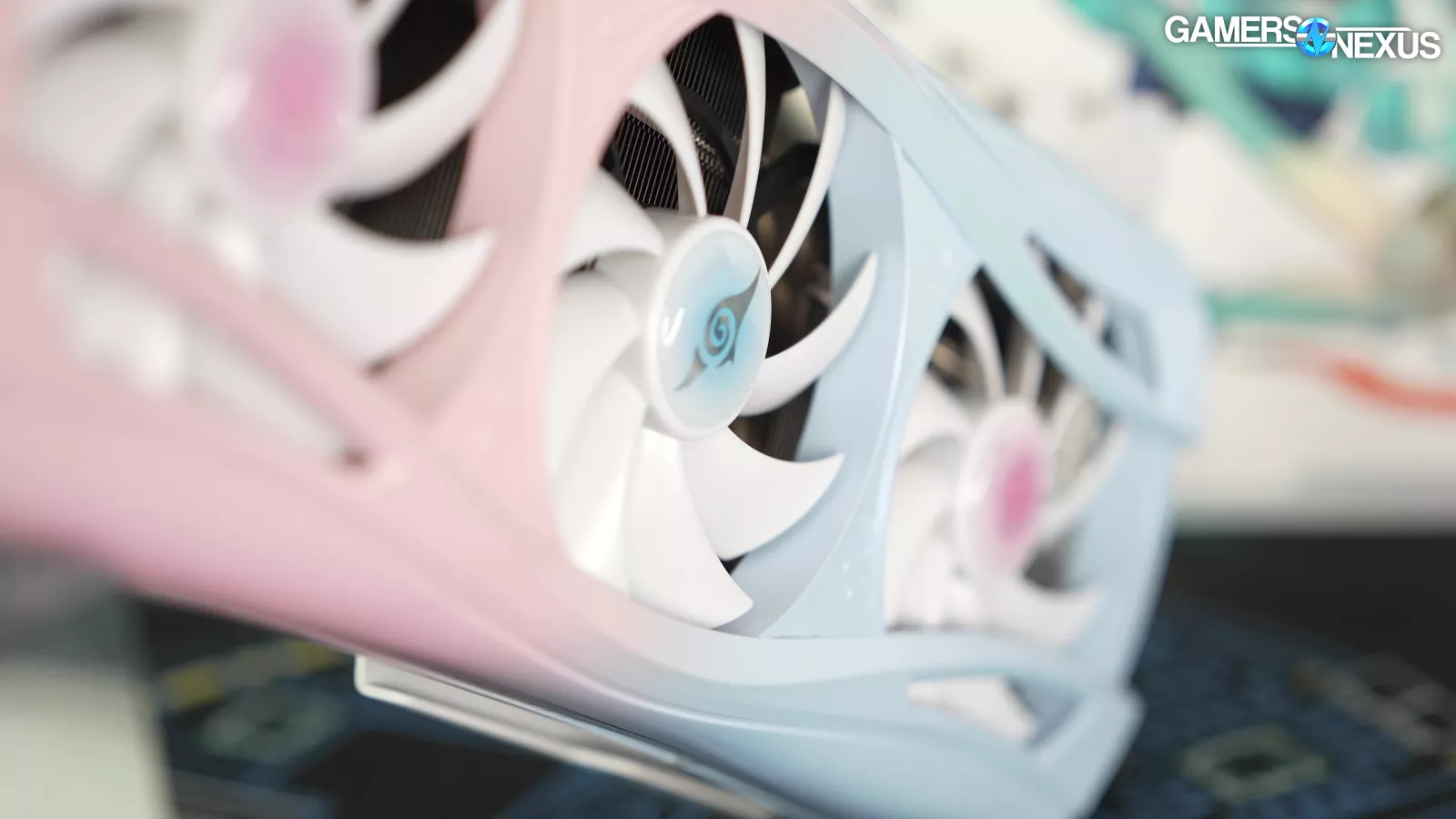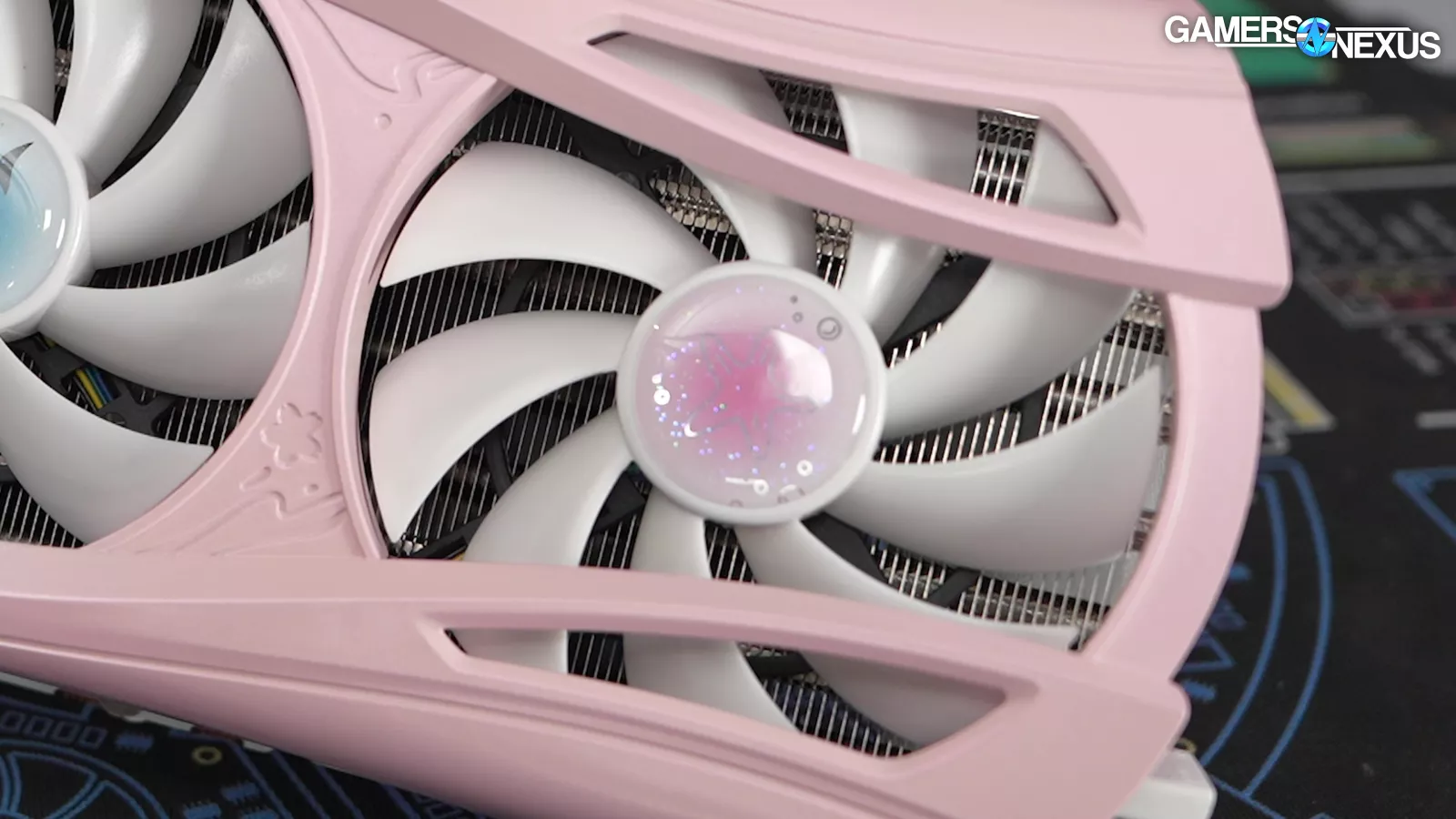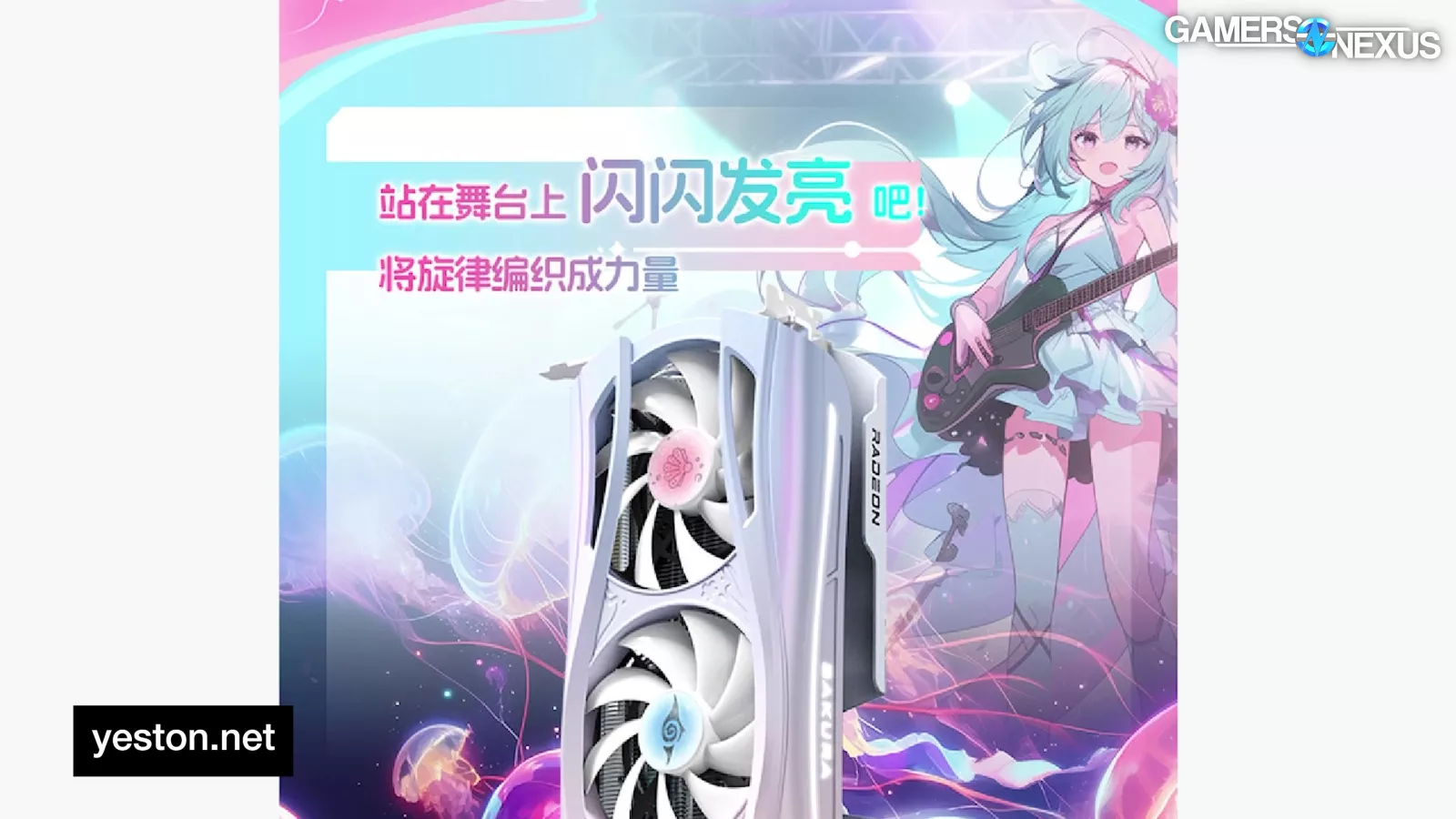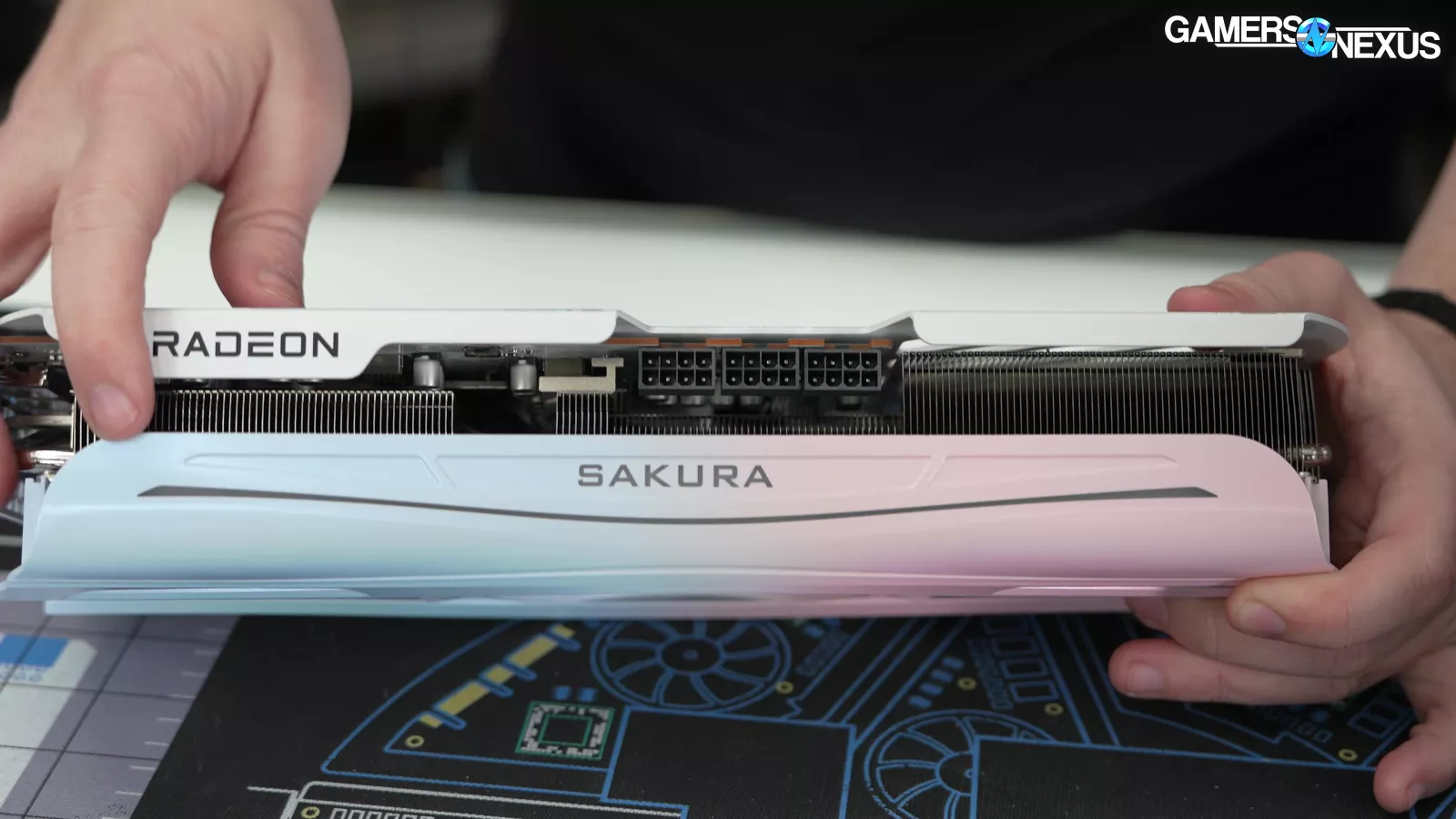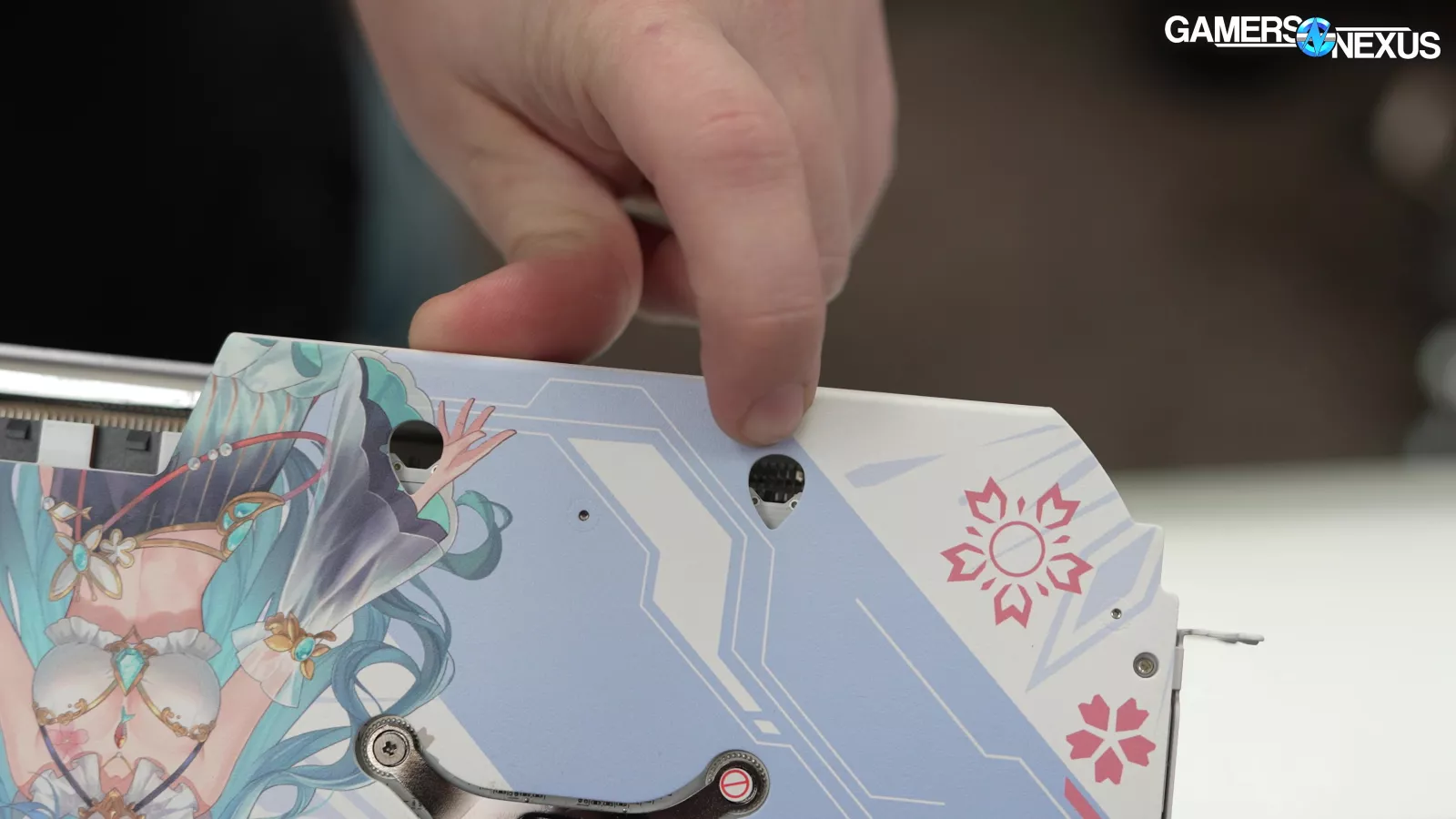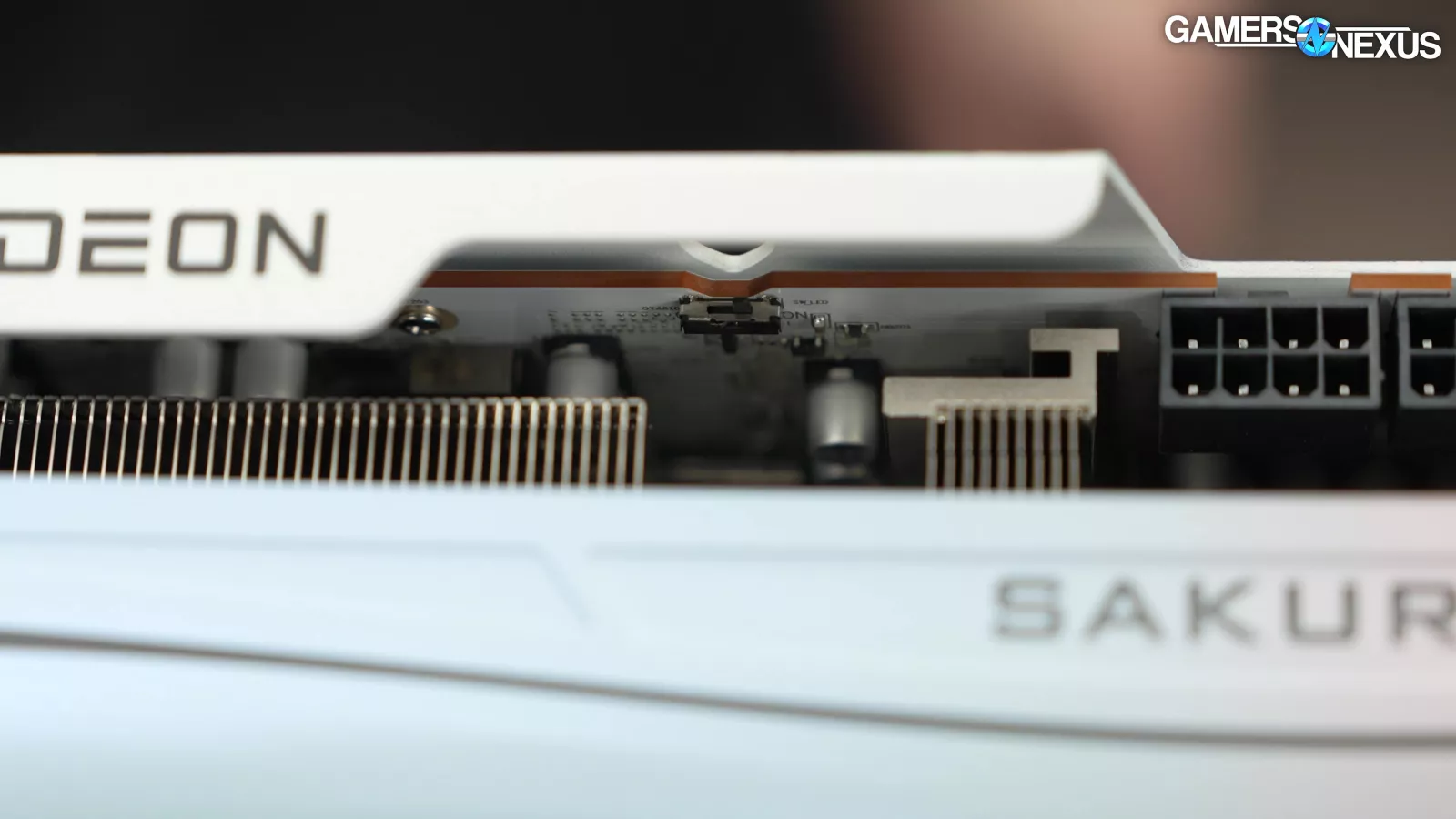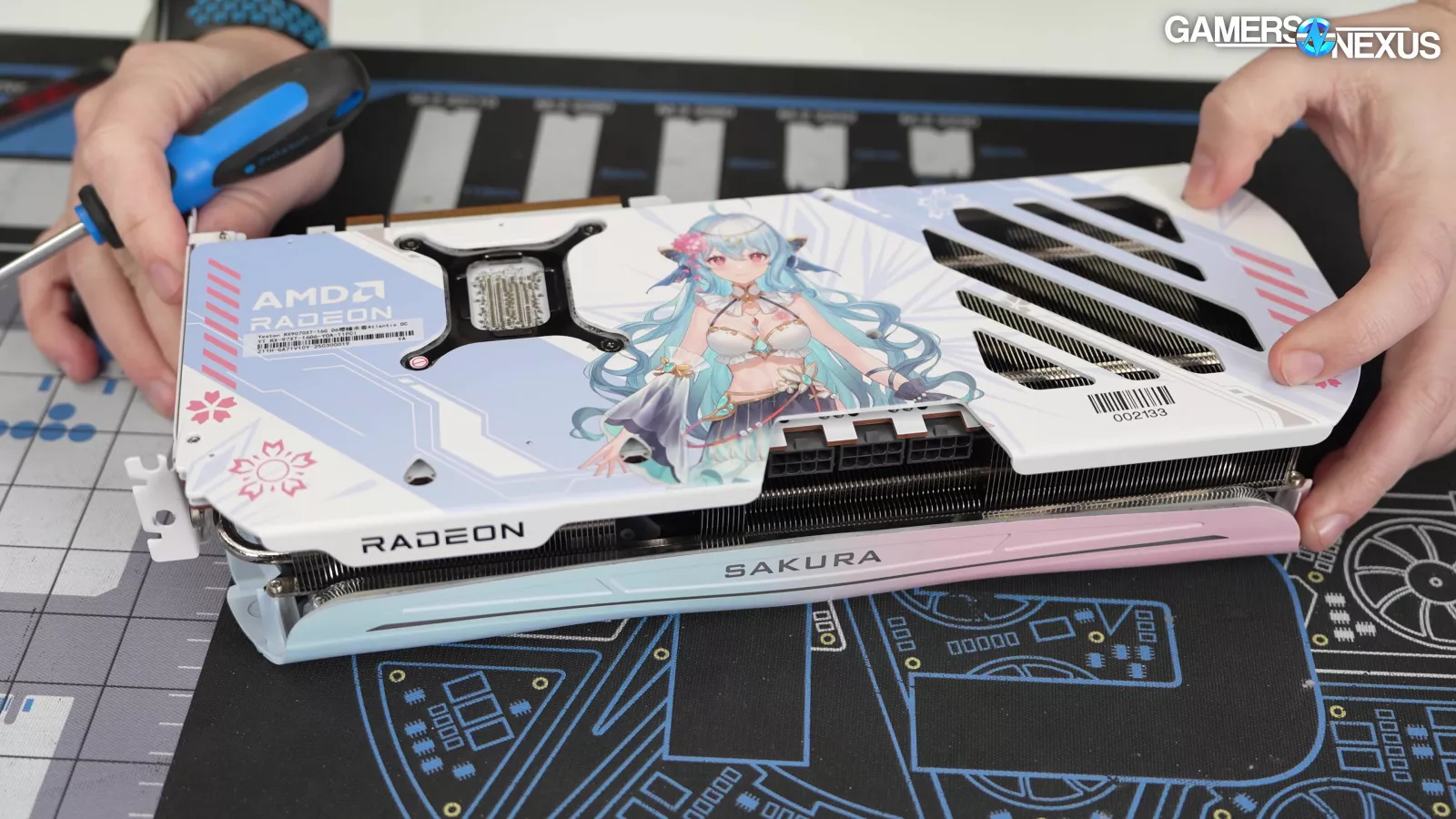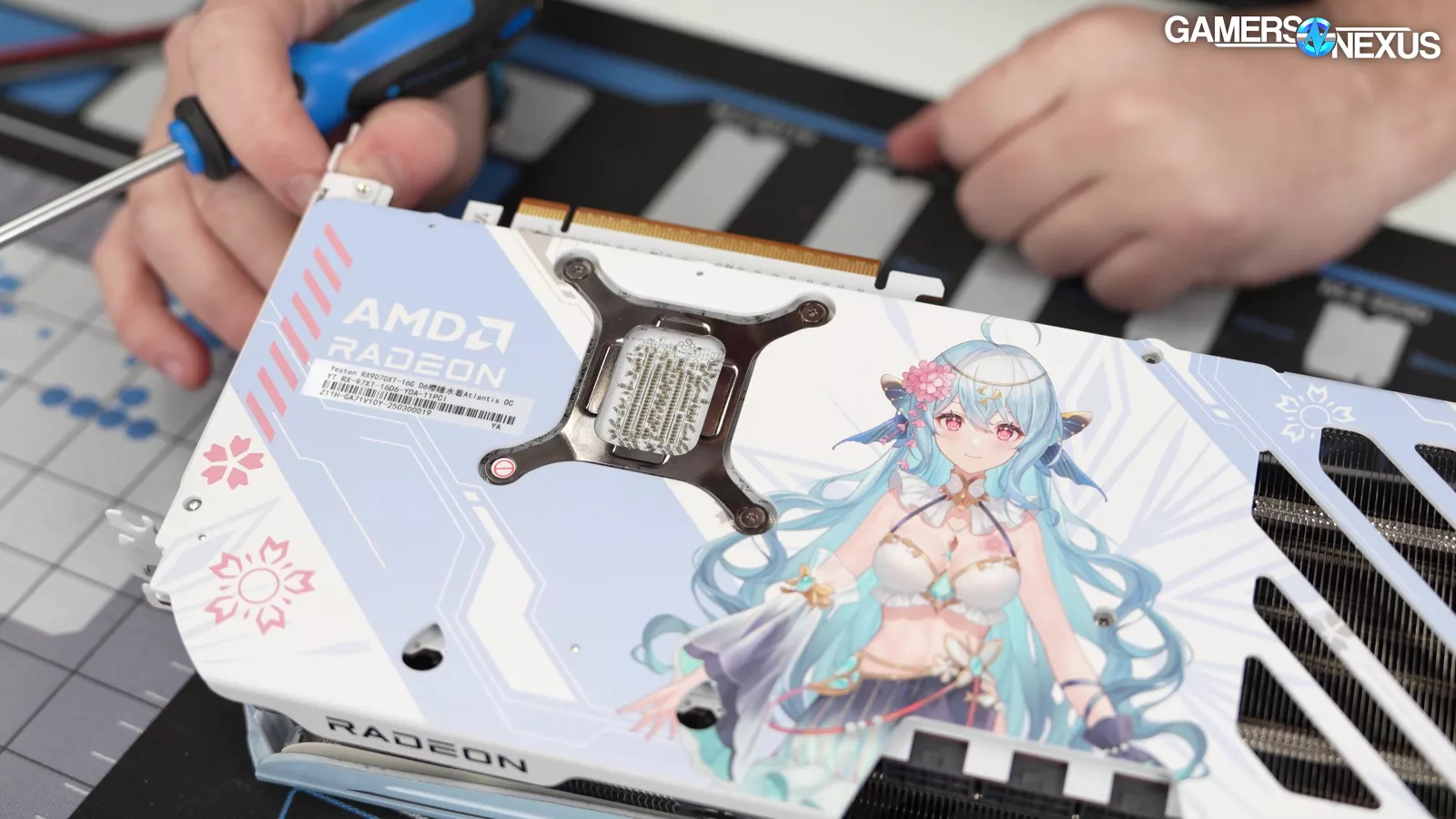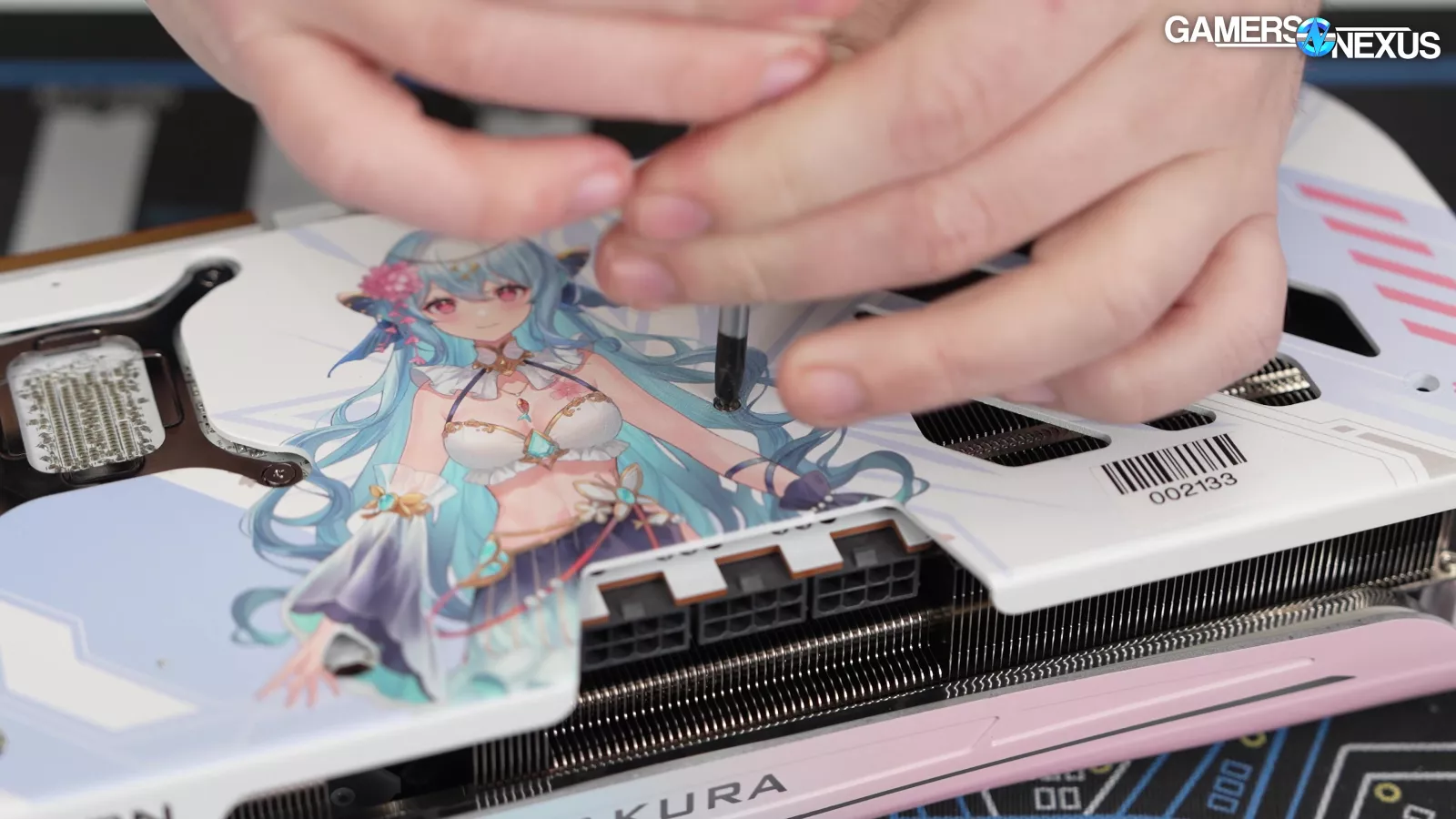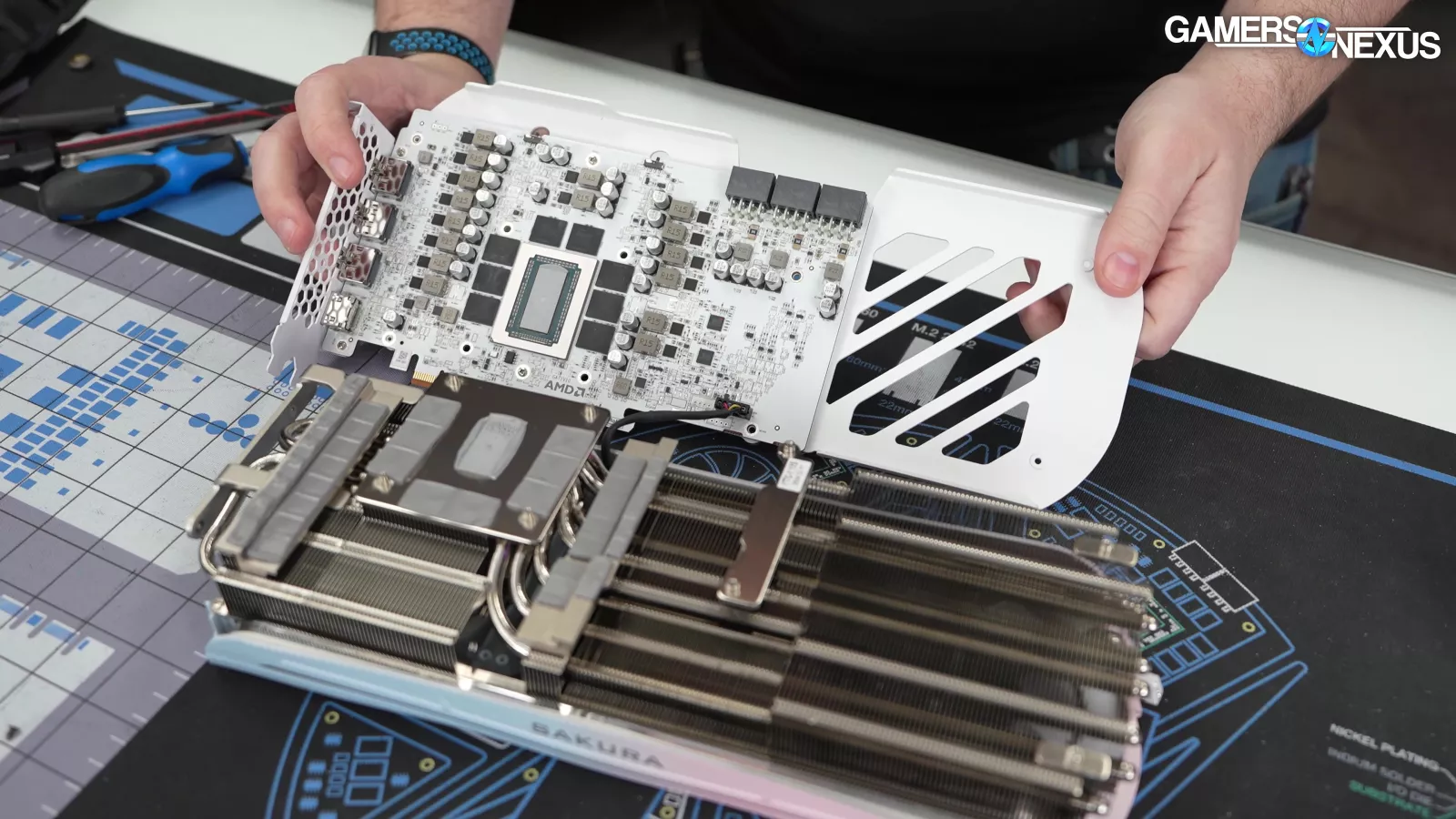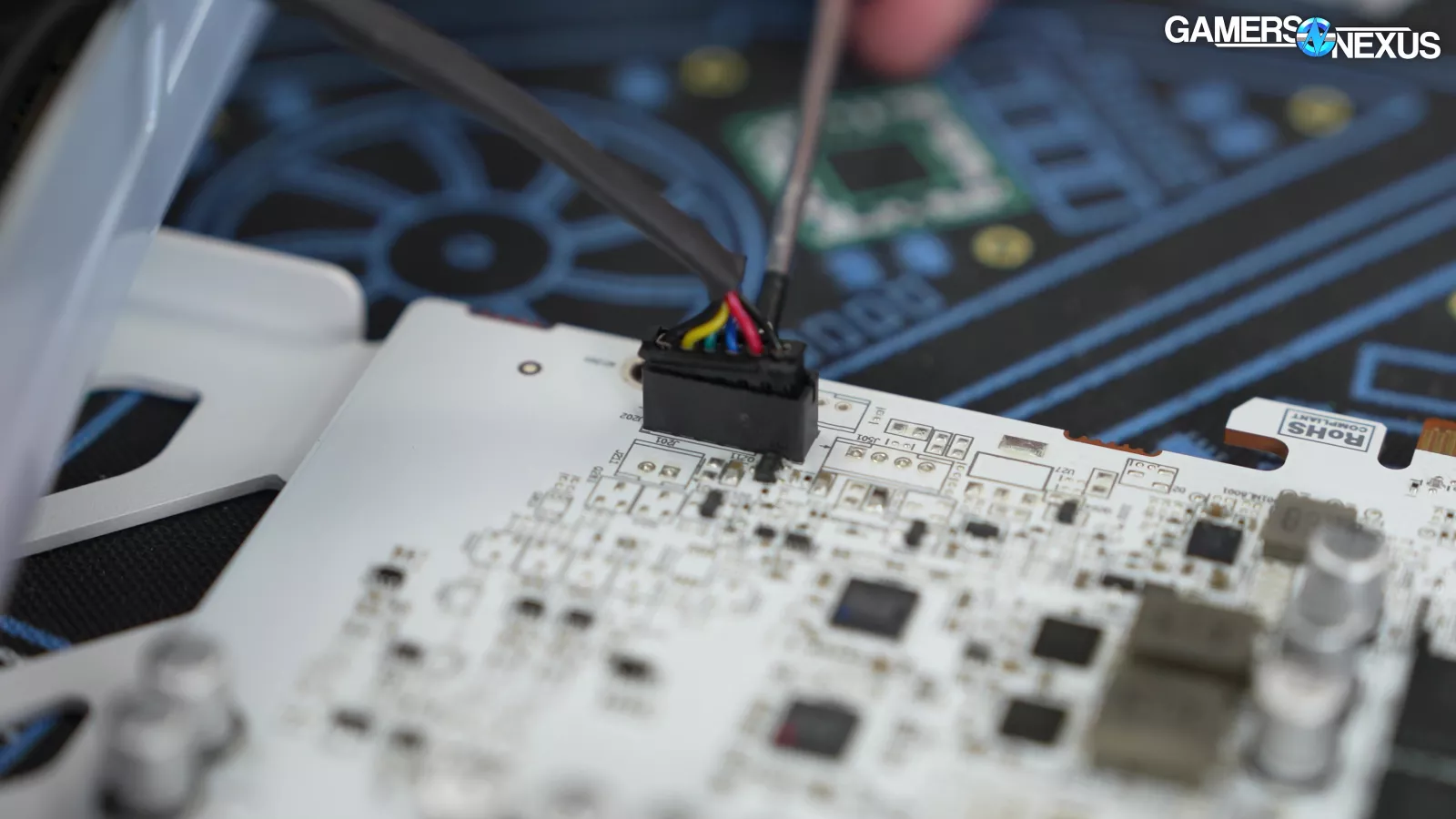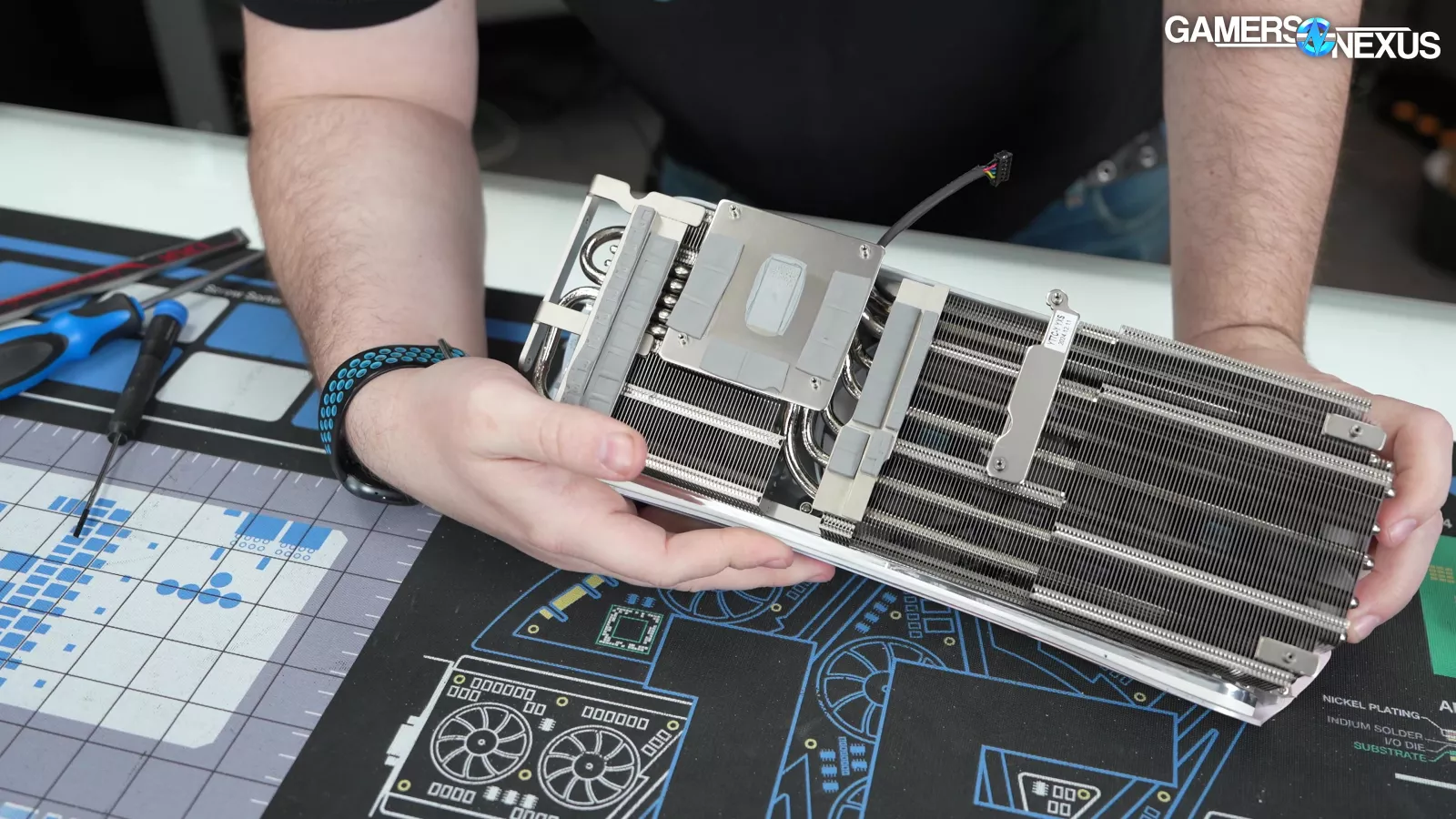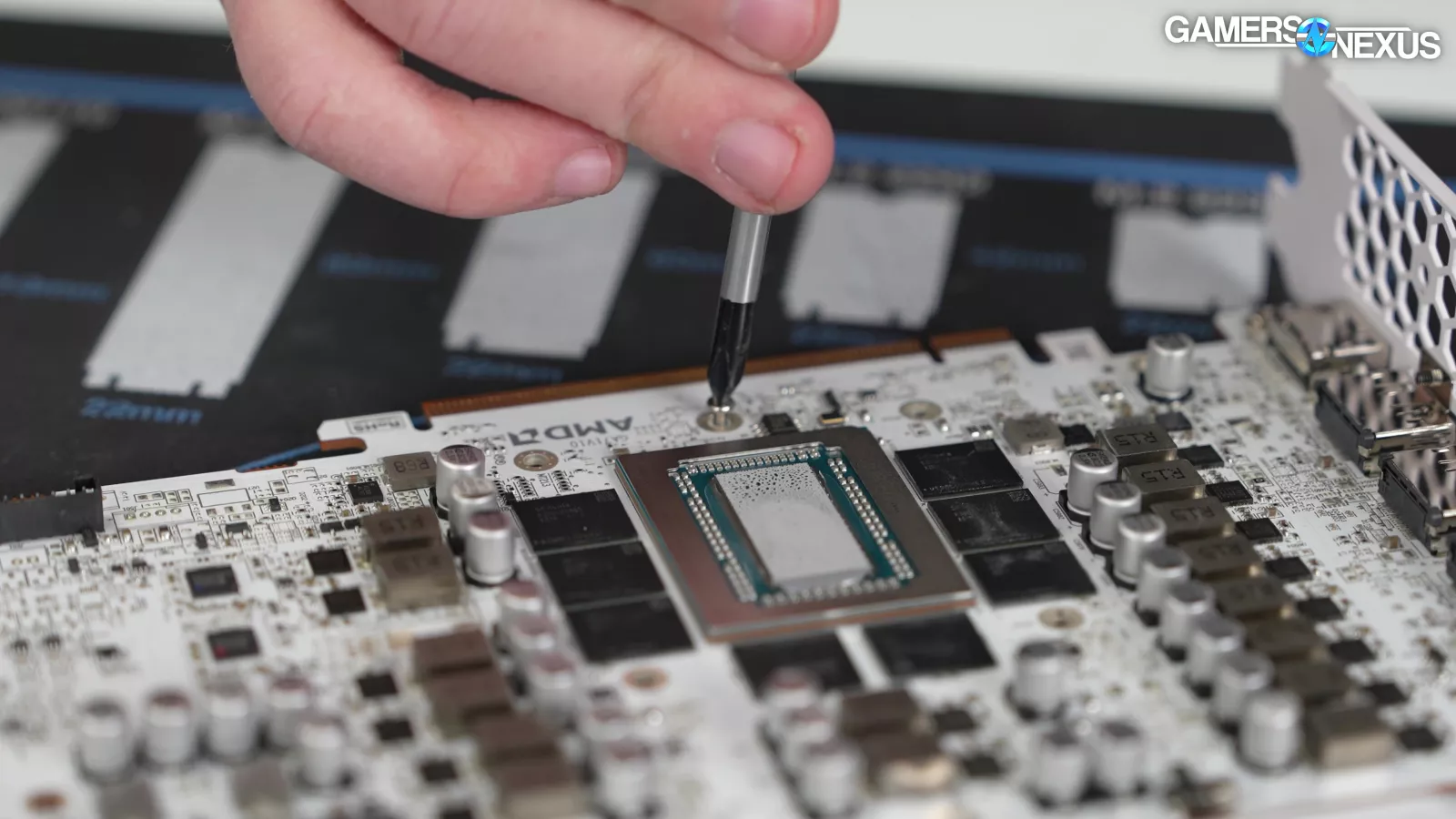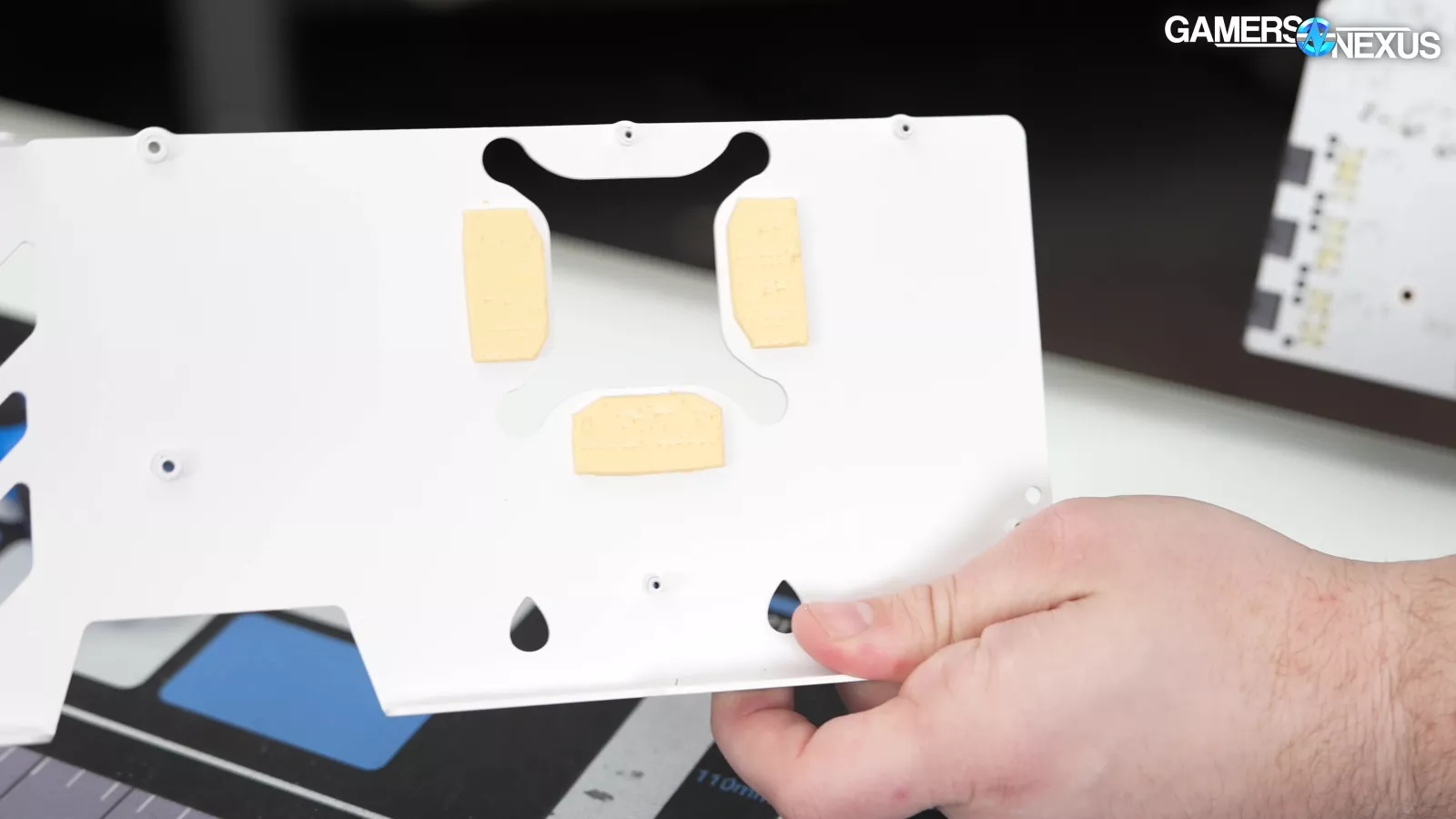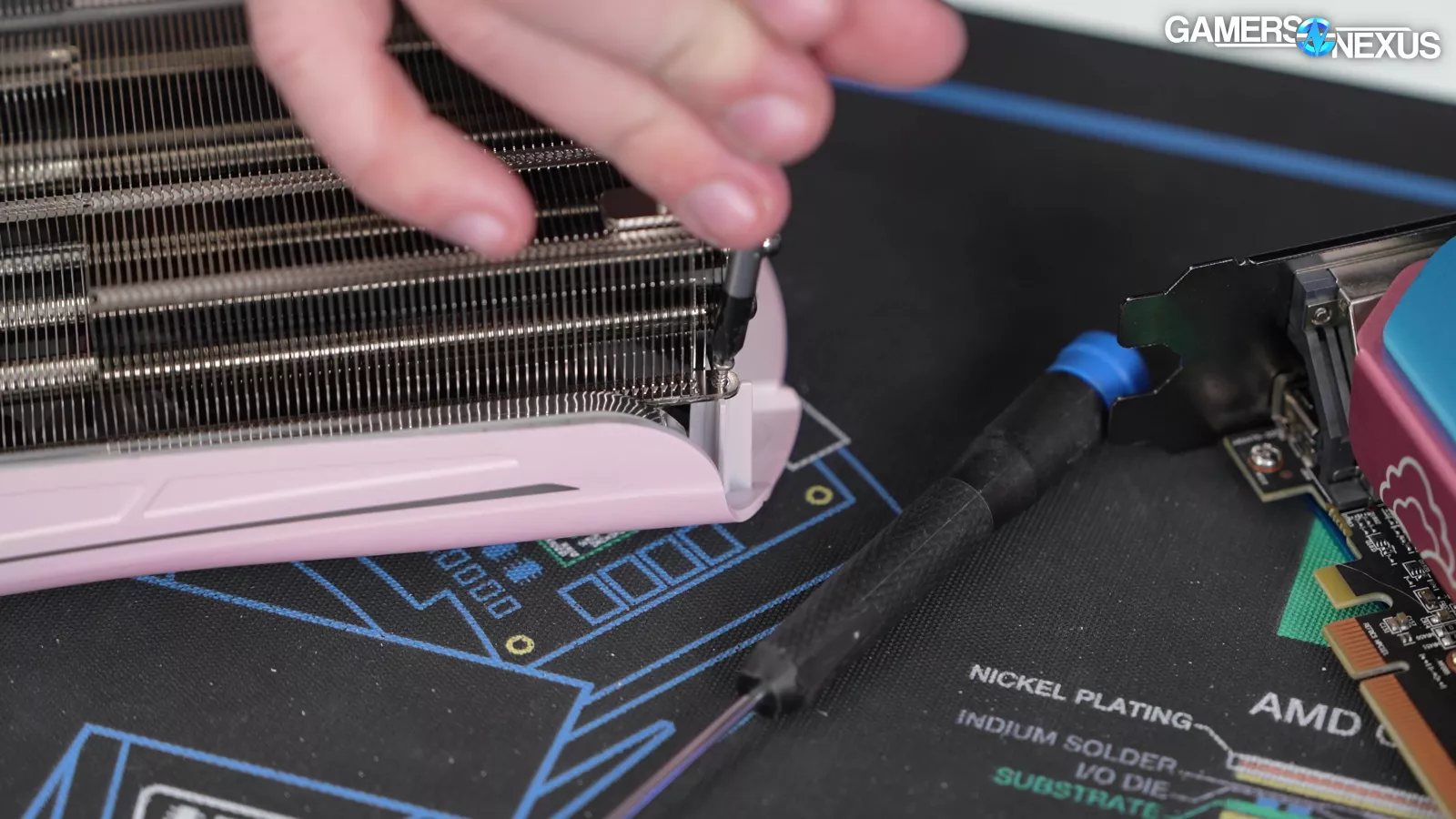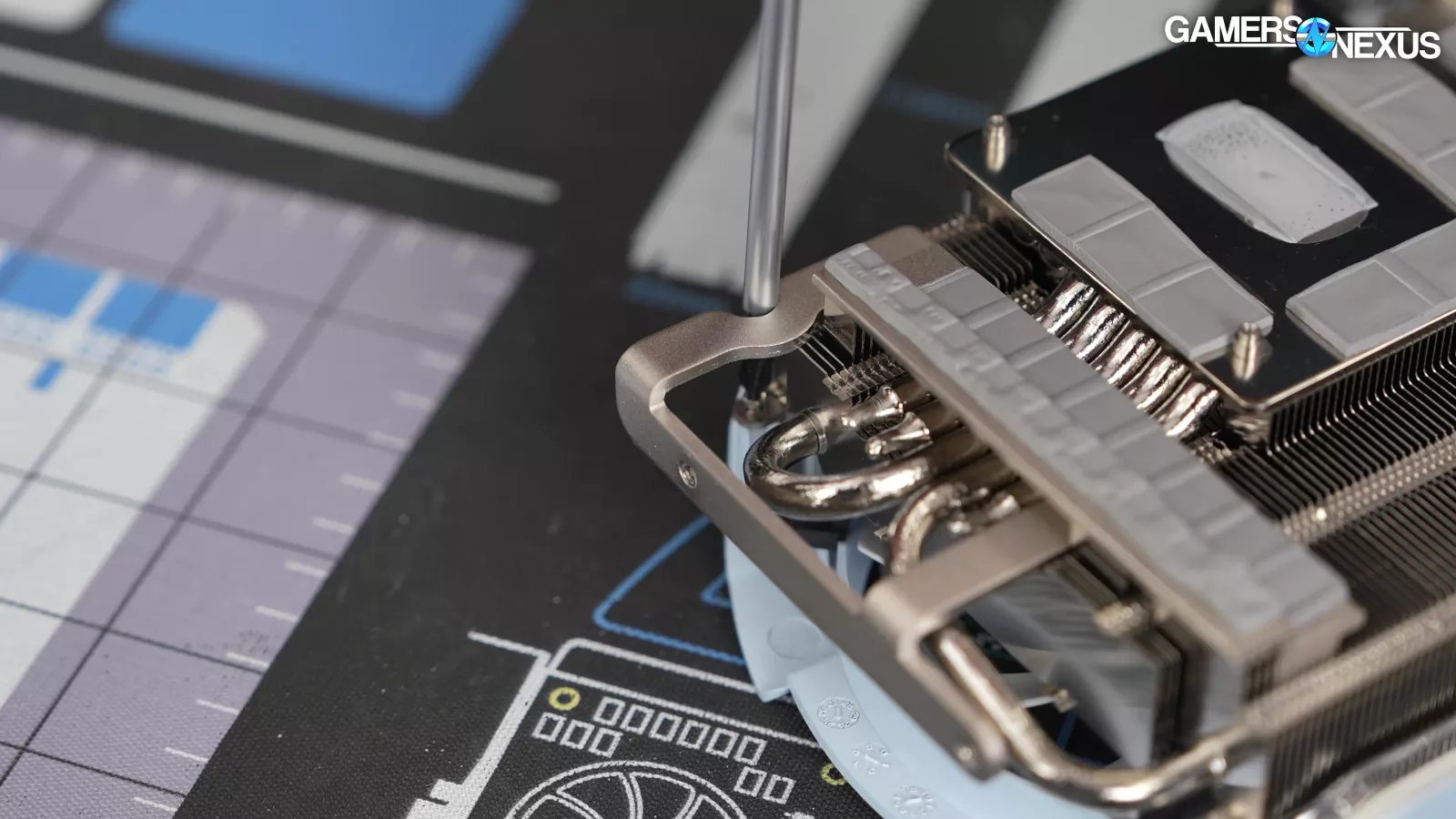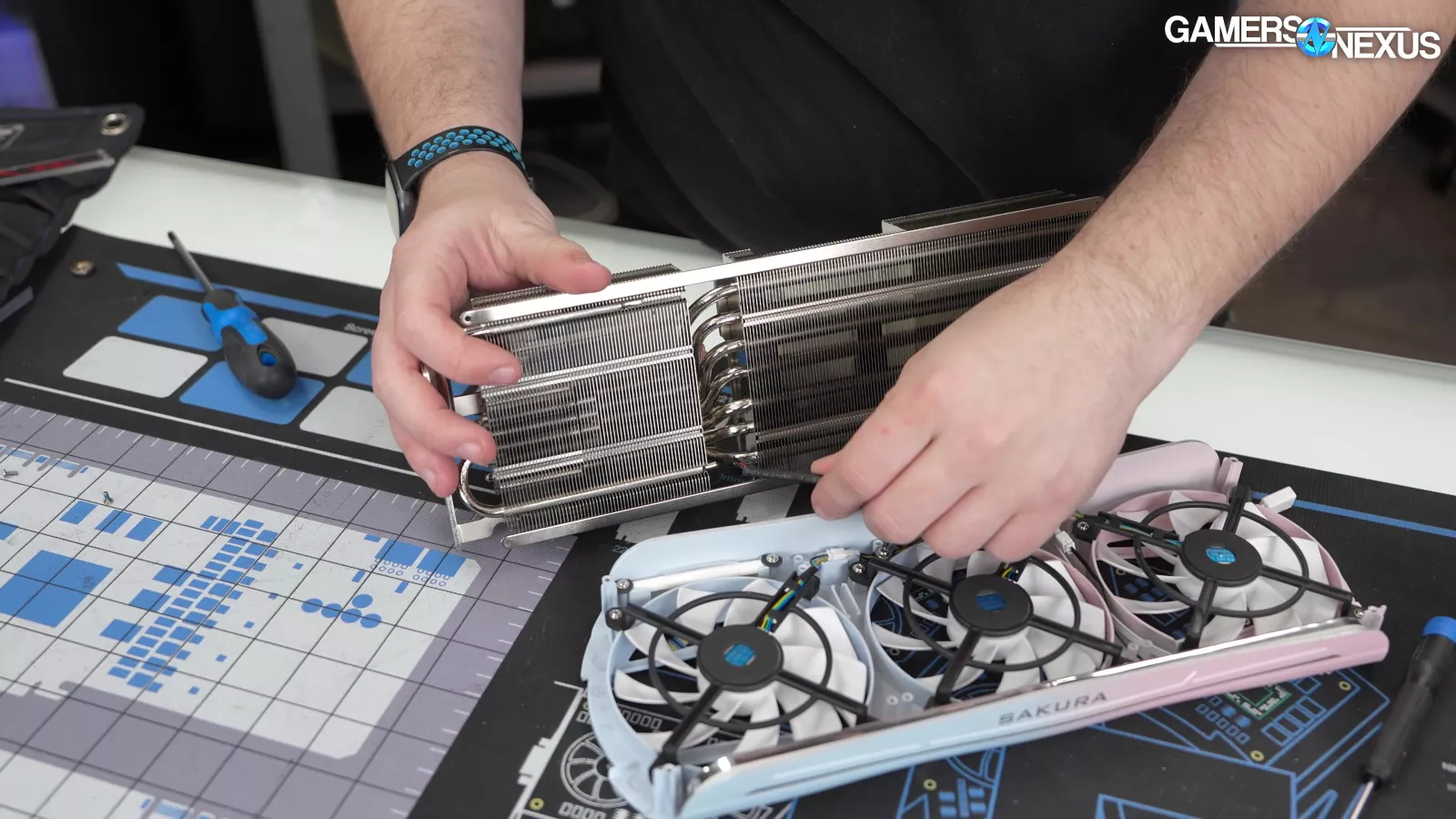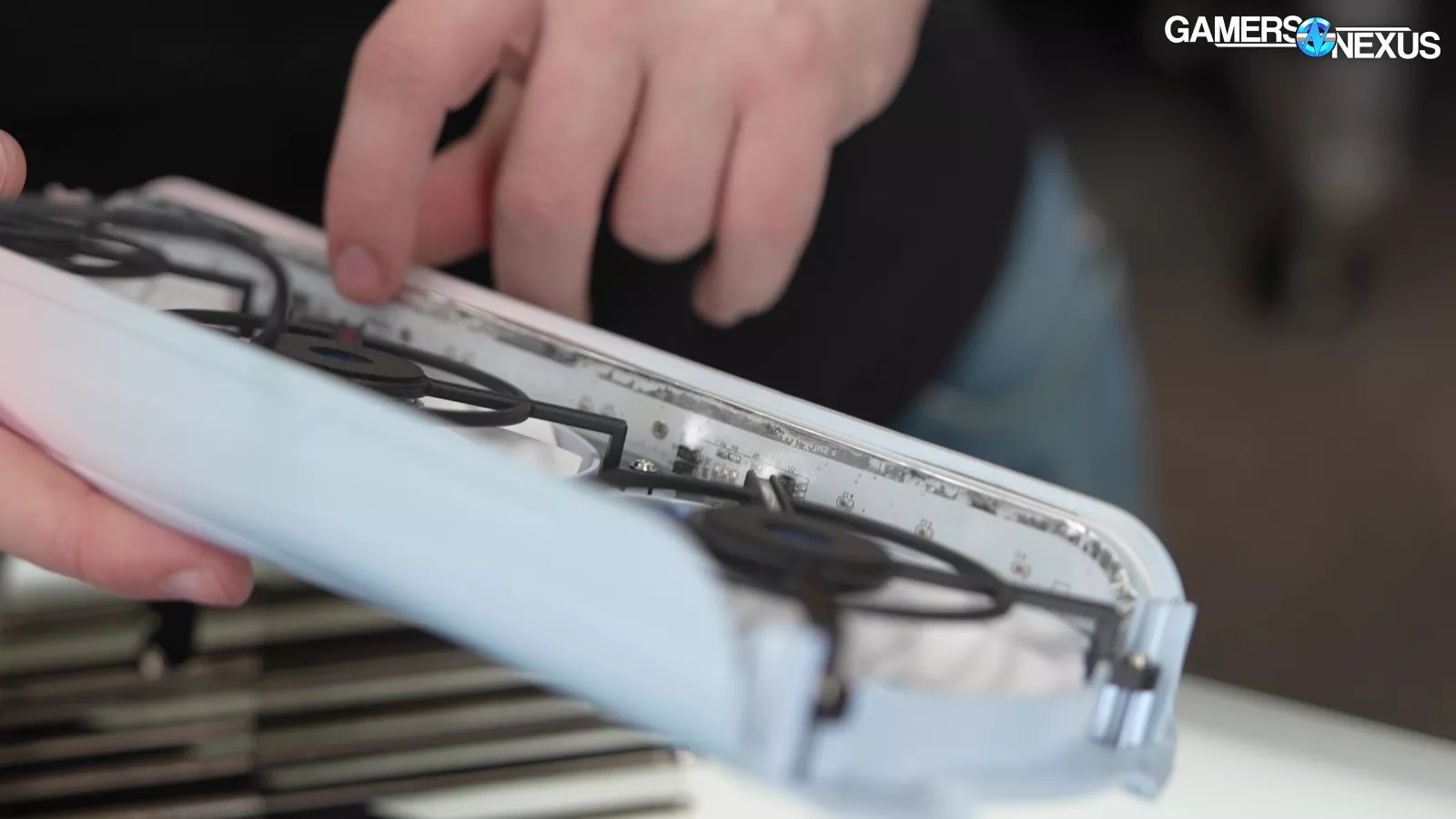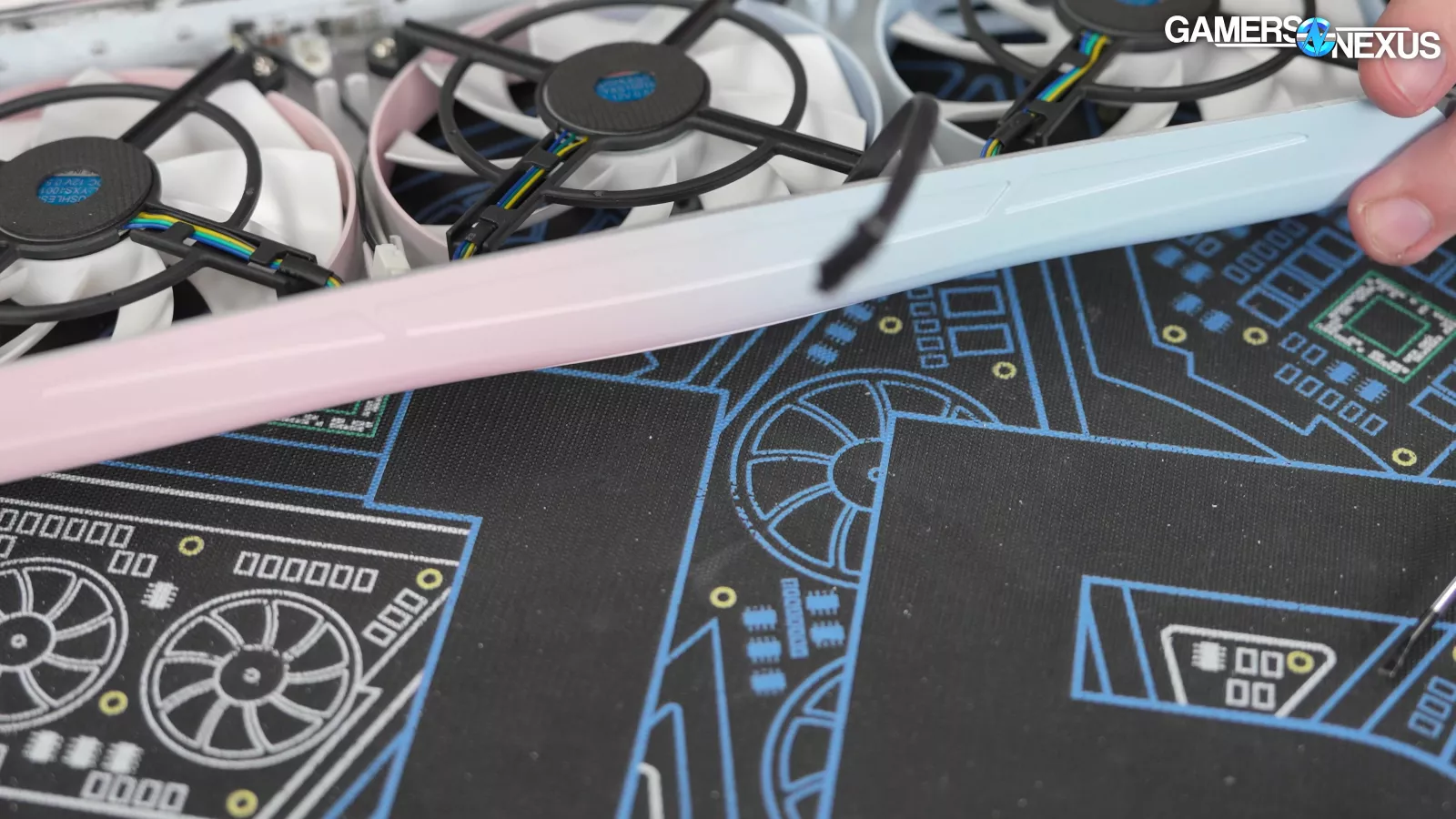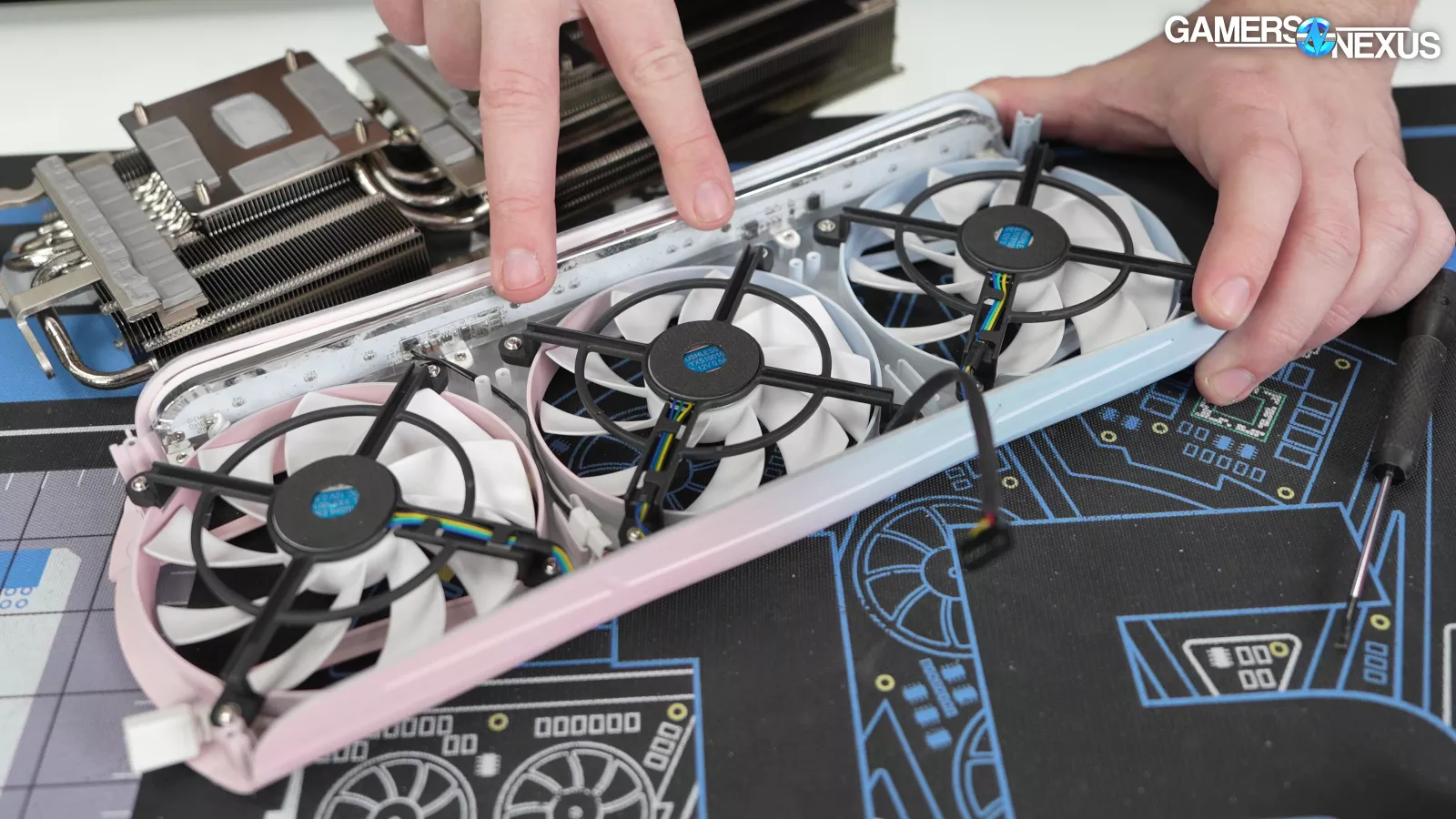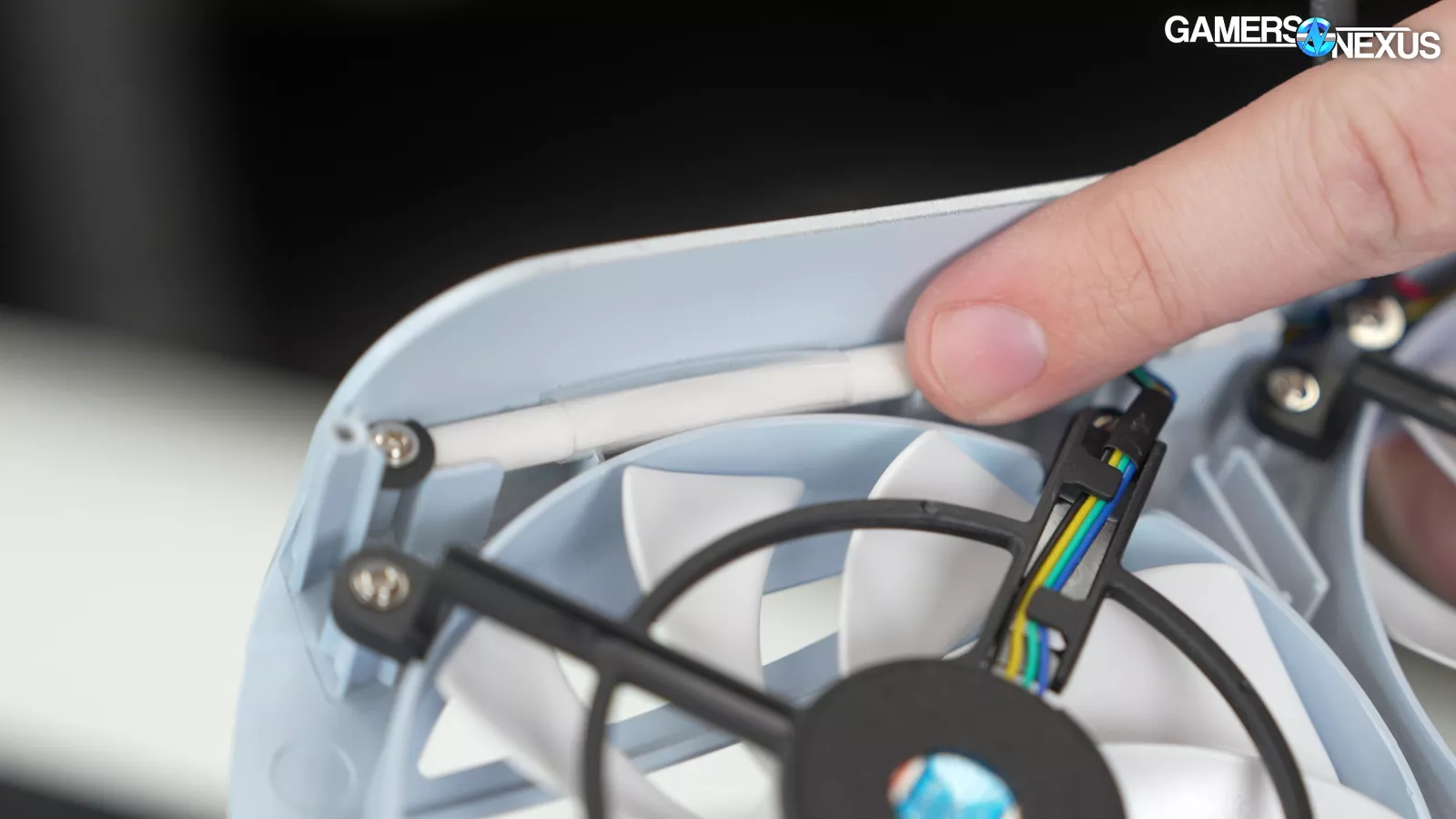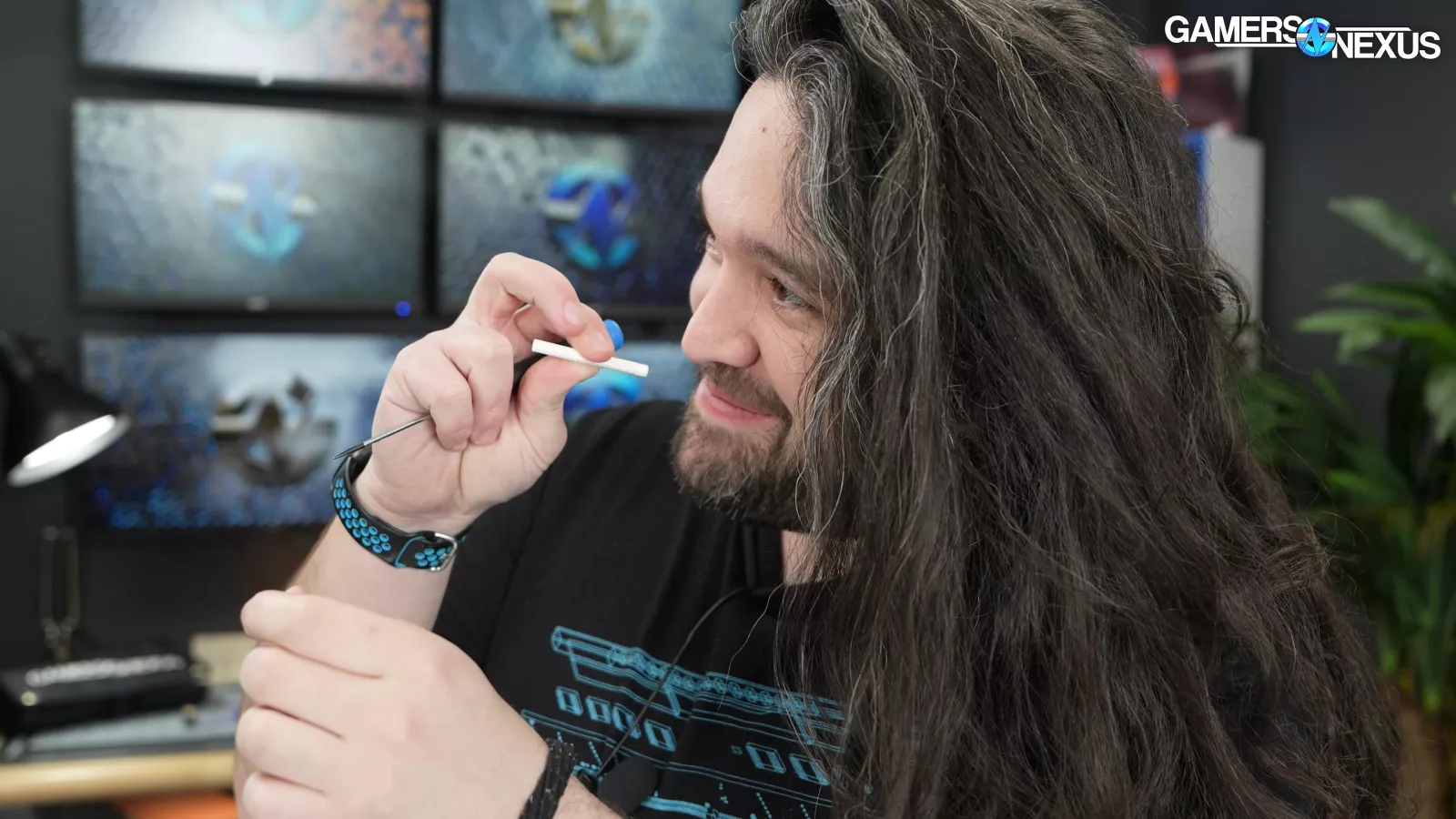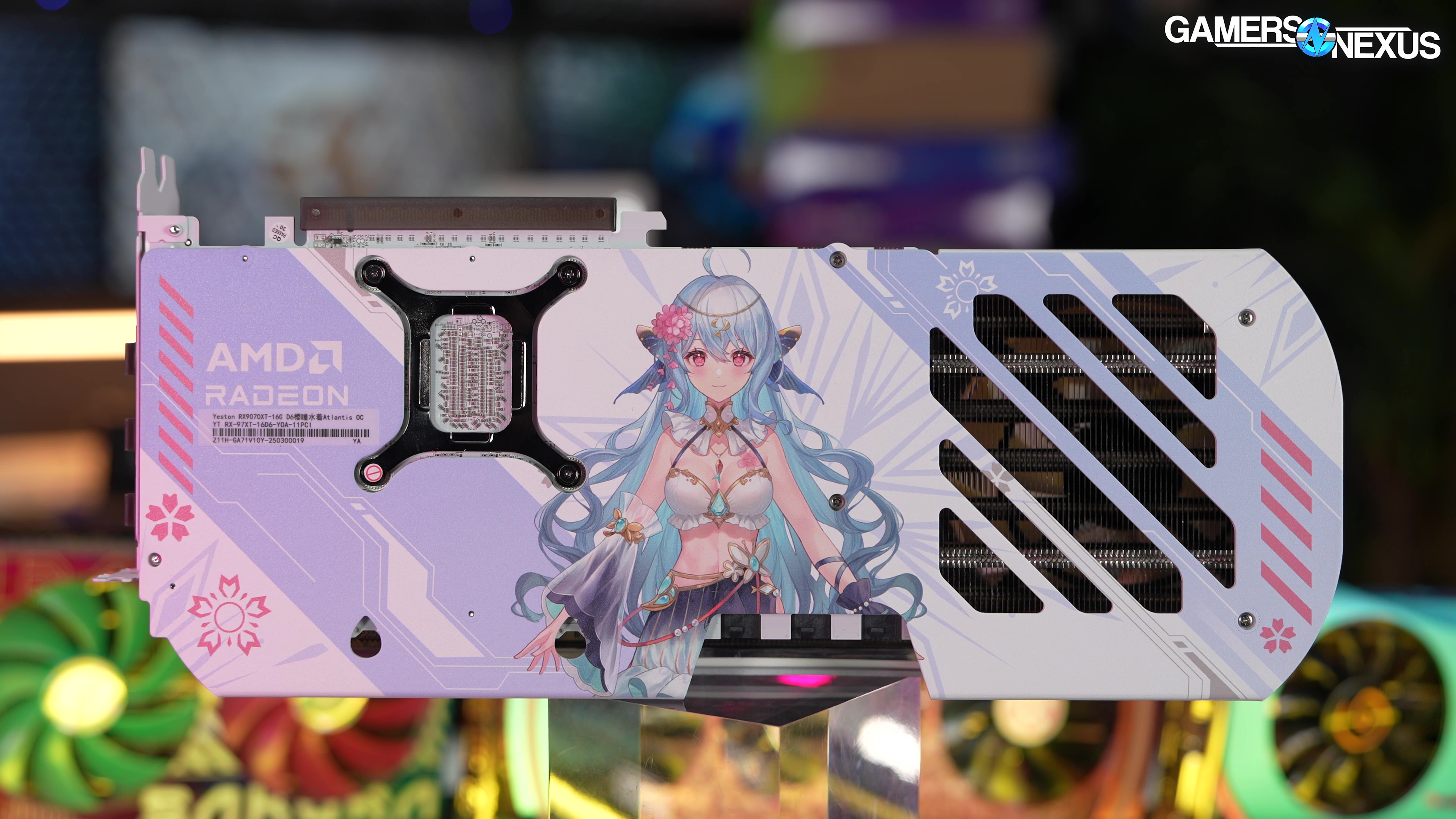
Wild Design: Yeston RX 9070 XT "Waifu" Sakura Sugar Atlantis GPU Review & Benchmarks
Last Updated:
We review the Yeston RX 9070 XT Atlantis OC and test its thermals, acoustics, and performance
The Highlights
- Yeston’s RX 9070 XT shows that not every video card has to be a black-and-RGB rectangle
- The card’s thermal and acoustic performance is kind of middling
- The card has dual VBIOS, an LED switch, and smells like a car freshener
- Original MSRP: $900
- Release Date: March 2025
Table of Contents
- AutoTOC
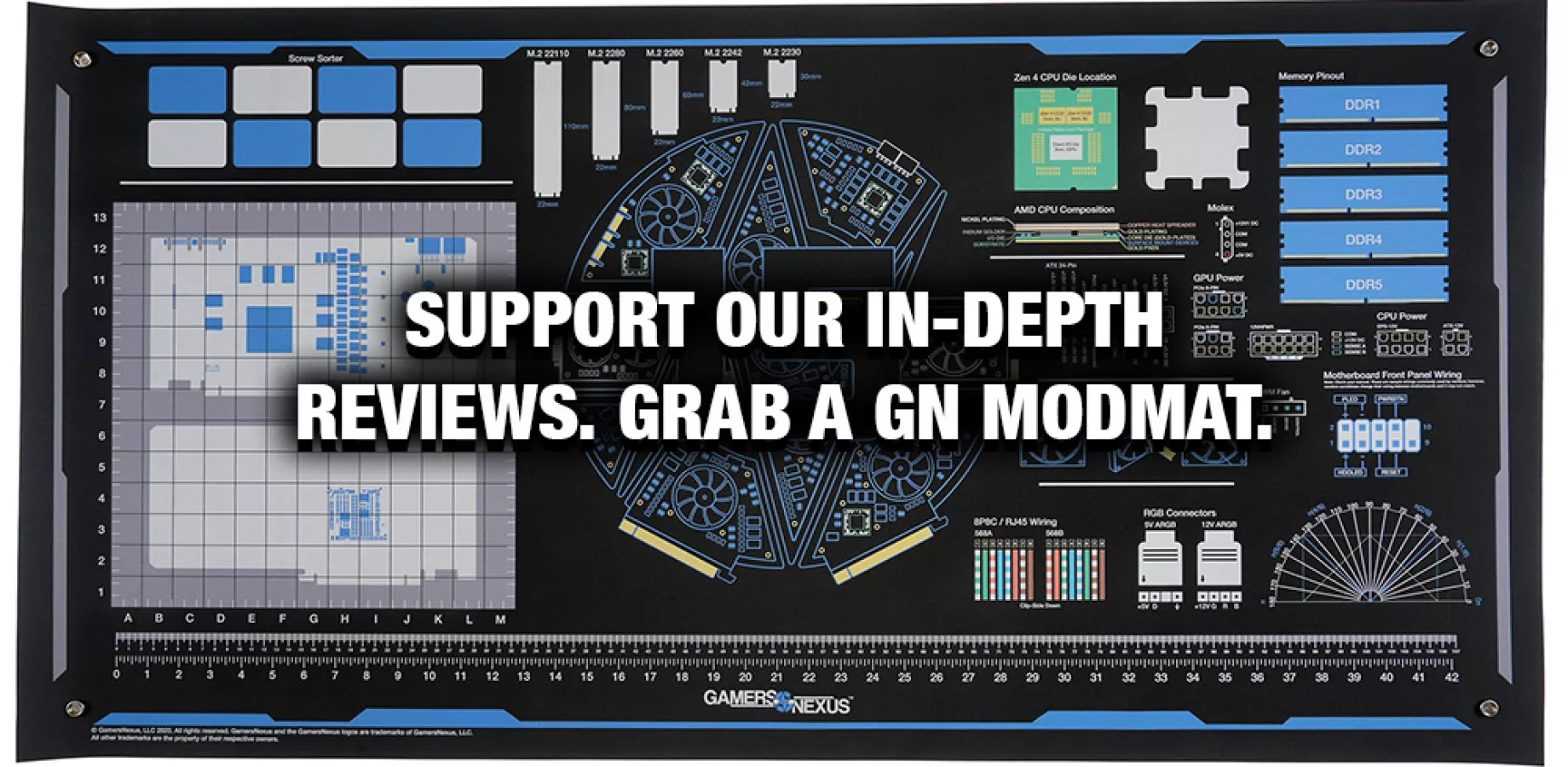
Intro
Today we’re reviewing the Yeston Sakura Sugar Atlantis RX 9070 XT OC. The card has a VBIOS switch, an LED switch, 3 fans, and it is supposed to smell like the ocean. The company even shows it getting dunked in the ocean in their promo footage.
Editor's note: This was originally published on March 22, 2025 as a video. This content has been adapted to written format for this article and is unchanged from the original publication.
Credits
Test Lead, Host, Writing
Steve Burke
Testing
Mike Gaglione
Camera, Video Editing
Vitalii Makhnovets
Writing, Web Editing
Jimmy Thang

The bad news is that it’s $850 to $900, depending when you find it in stock. The good news is that the prices are just made up and none of this matters anyways. This is still somehow cheaper than some of the other flagship 9070 XT cards out there.
Yeston is the China-based video card manufacturer that we first found out about when we reviewed the Yeston RX 580 Cute Pet in 2019, and we never knew it’d turn into a half-decade-long series of reviewing their different approach to GPUs.
In the time since, we also looked at Yeston’s Cute Pet aluminum mini PC case. We also tested their RX 5700 XT, which we called “Waifu edition.” We later looked at their RX 6700 XT Sakura card with blue, purple, and white coloring, and most recently, we tested Yeston’s 7900 XTX Sakura Sugar GPU, which actually had a less fan-service-y thematic and blended some neon Cyberpunk-like styling in a way that makes it clear the big video card partners can absolutely do more - and it doesn’t have to just be pink and purple, either.
Surprisingly, Yeston has managed to make overall effective designs despite clearly investing the majority of its focus on looks or theming. The old RX 580 Cute Pet and more recent Sakura cards, whether or not they’re your specific style, have shown that there’s a ton of room for more uniquely visualized video cards without going pure black-and-RGB. They’ve also done well overall with thermal design.
But Yeston has gone overboard: They have a whole universe now.
In addition to having backstories and lore written into its manual for its characters in an almost comic book like style, Yeston has just recently debuted its new cast of future back plate art characters.

There’s this guy, from a Cyberpunk dystopia. His name is “Game Ace.”
But we assume the GPU will be widely rebranded as the “Yeston Husbandu” edition. They’ll have anime GPUs for everyone.
Let’s get into the review.
The new RX 9070 XT Atlantis we’re reviewing, despite being called “Atlantis,” isn’t water-cooled. It uses 3 fans and a modestly sized finstack.
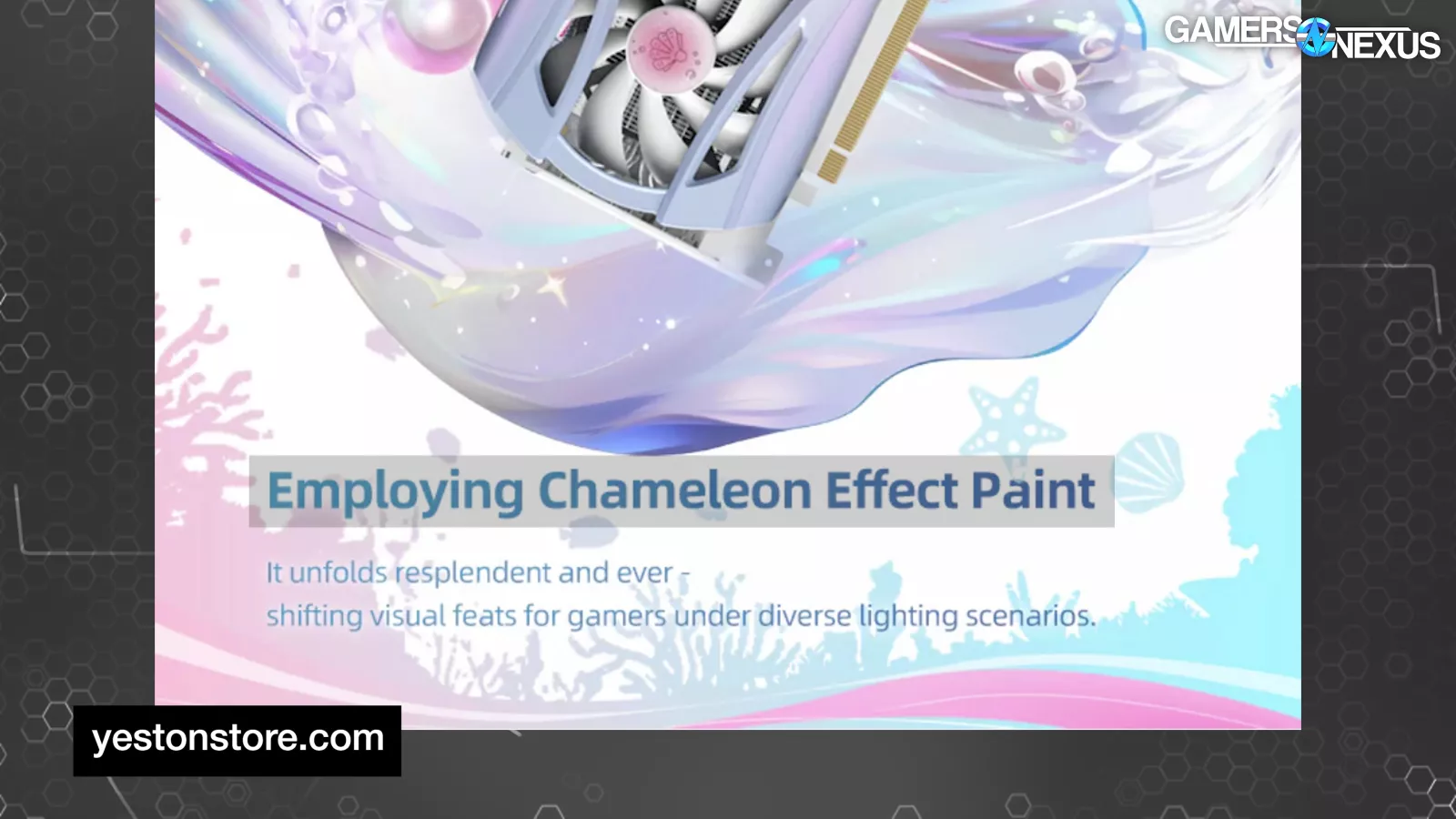
Yeston’s marketing says it employs “chameleon effect paint” that “unfolds resplendent and ever-shifting visual feats for gamers under diverse lighting scenarios,” which, credit to them, is like the inverse of PowerColor’s prologue about hellstones and dark obelisks.
The Yeston card has a dual-color shroud with a fade from purple to pink and has color-matching everywhere. They’ve done a good job with the color theory on this card. The PCB is white to match the white back plate, showing good attention to detail, as is the PCIe bracket. The stickers on the fans even have tiny dots of glitter inside of them to dazzle and impress all your bros when they check out your PC for LAN parties. The back plate has, uh-- well…
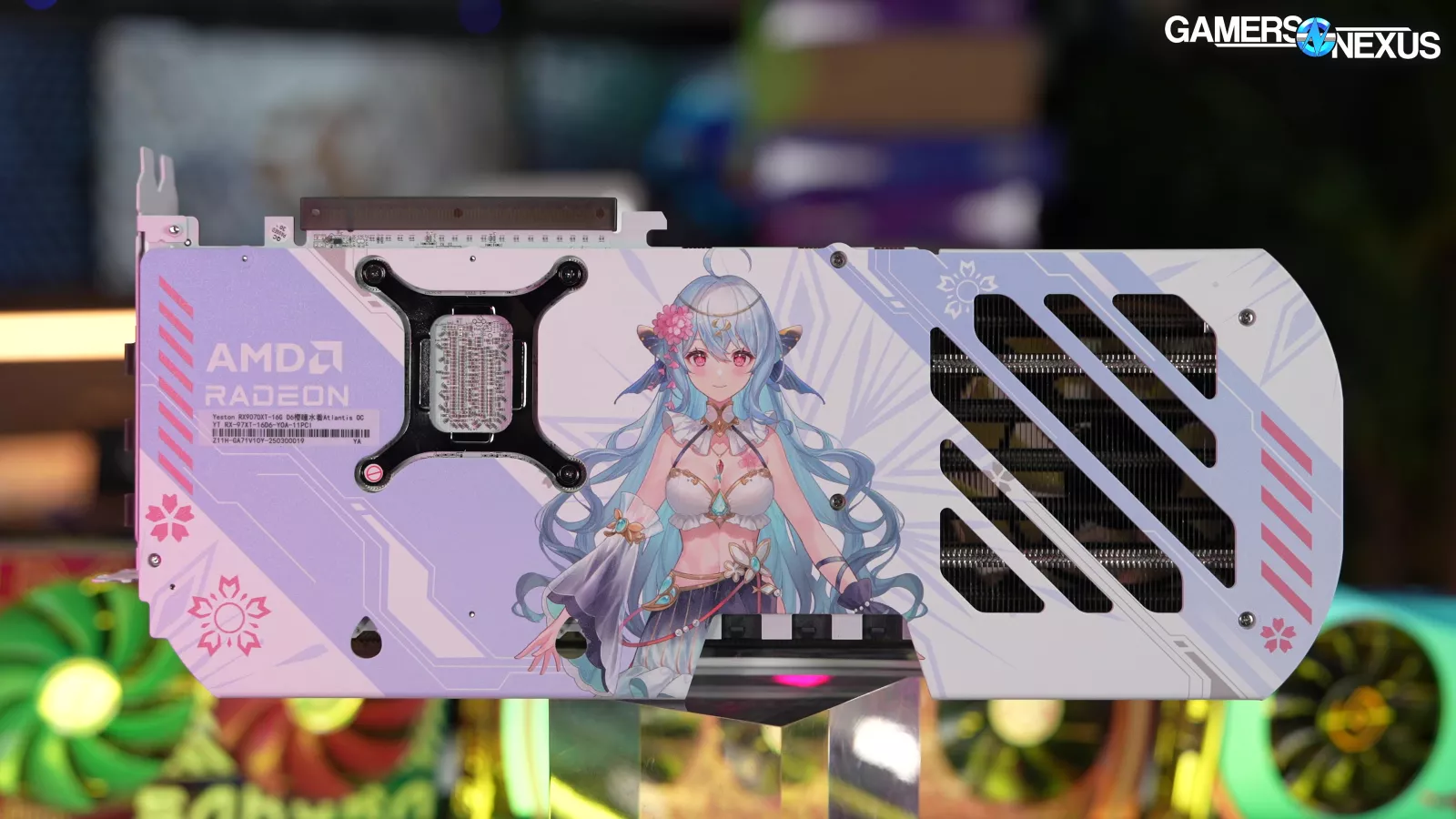
...This. We suppose it’s not surprising what we’d get with Yeston involved so that hasn’t changed.
Yeston’s 9070 XT edition Waifu has a backstory once again, this time apparently involving... playing guitar and singing, or something. We’re not really sure.
But we’re going to take credit for popularizing the Yeston cards as the “Waifu” cards back before we even knew the name of their company.

What we didn’t know was that the company itself would then follow our lead and the immense popularity behind that name and begin calling their own products “Waifu” GPUs -- but they did.
And Yeston, if you’re reading this, we just want you to know that we didn’t mean it. That’s not meant to be a real name. It was a joke.
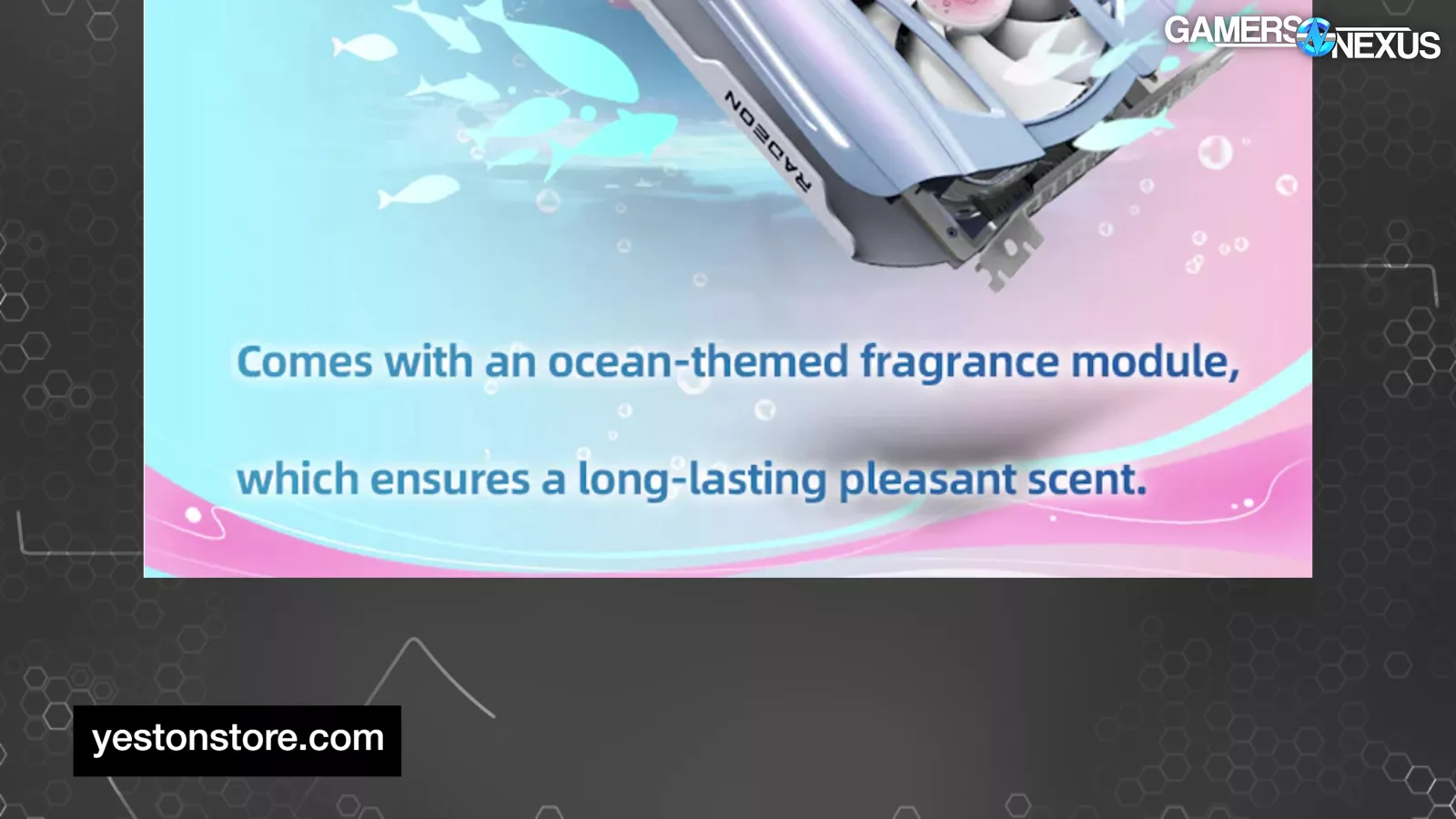
Anyway, the important part is that the marketing says it “comes with an ocean-themed fragrance module, which ensures a long-lasting pleasant scent.”
Well, we’ll see about that. We’re going to tear this card down now and look for the alleged “fragrance module.” It definitely has been blasted with perfume, but up until now, we haven’t seen that integrated in a “modular” way.
Yeston RX 9070 XT Tear-Down
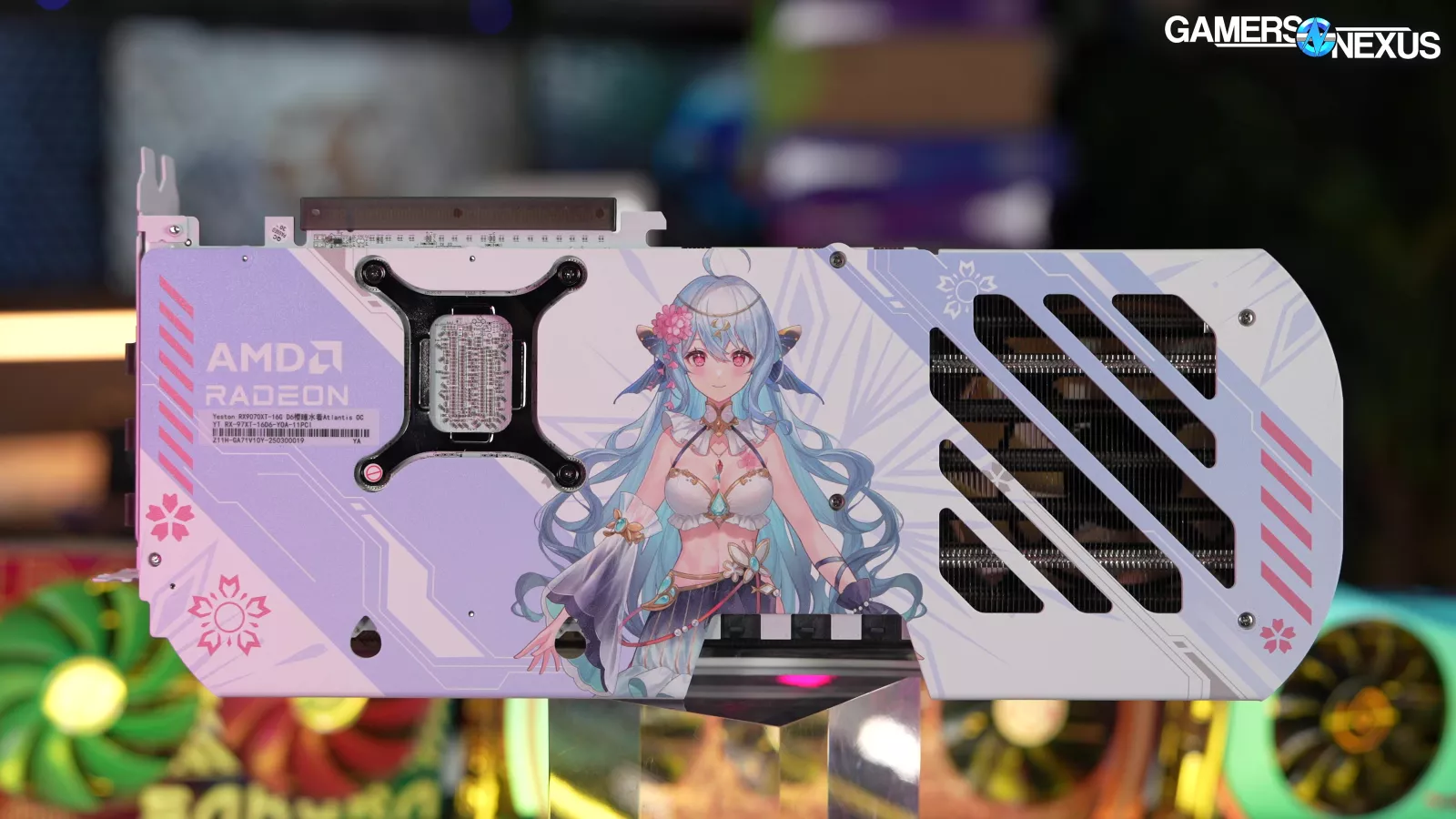
The back of the card has a large flow-through area.
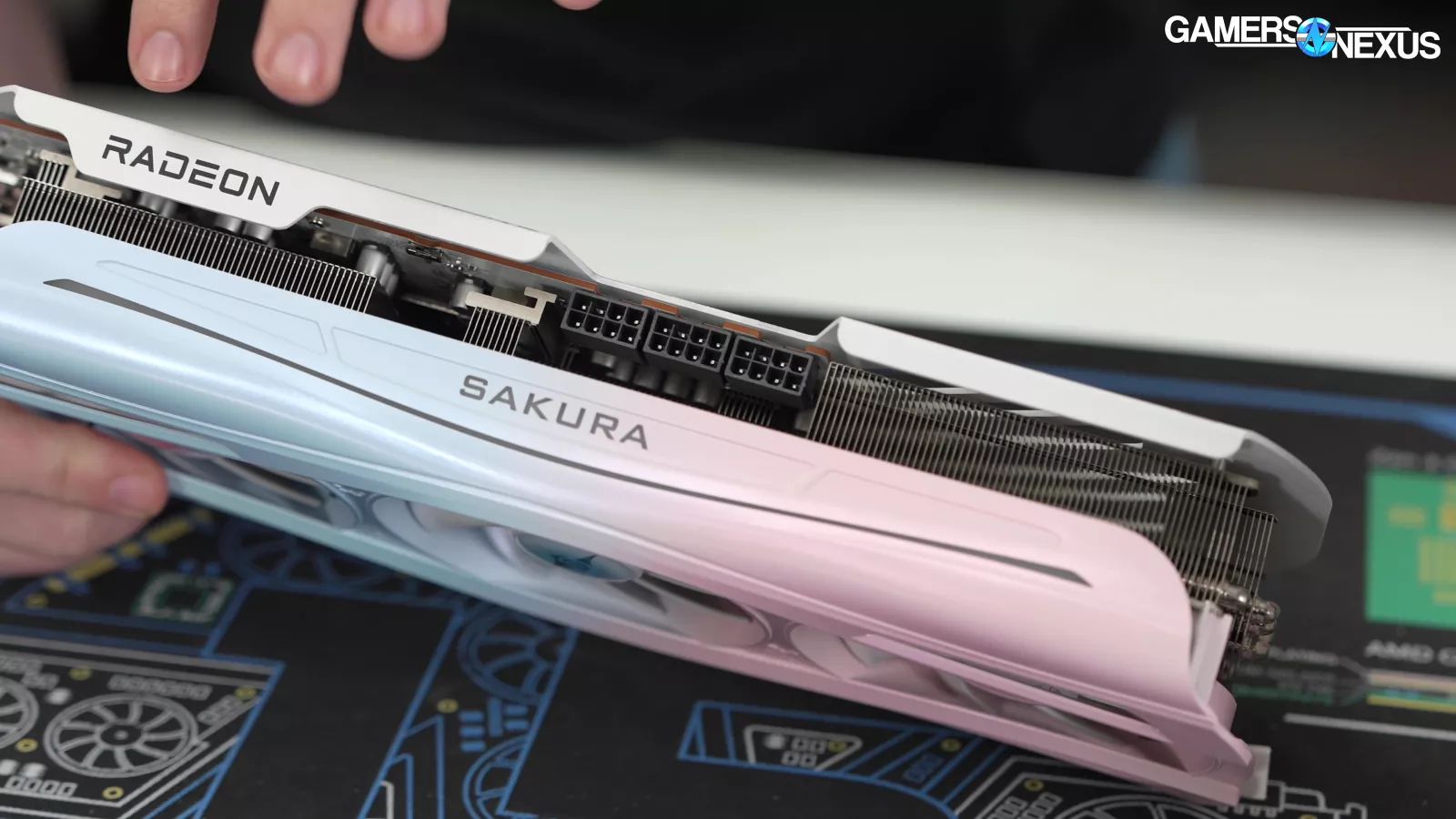
The fin stack is vertically-oriented, which means the air should go out the top and bottom of the card, which is pretty typical. One downside is that the card’s shroud is unfortunately covering maybe about 15% of the finned area. This means more area could have come out from the card if it weren’t blocked by a big piece of plastic. That is unfortunate and will affect thermal results.
The card has three PCIe power connectors at the top. On the back, there are 2 holes with switches inside them. One of them is a BIOS switch and the other is an LED switch toggle.
Removing the back plate is pretty straightforward with a handful of screws to unscrew. There’s also 4 screws which secure the heat sink to the PCB.
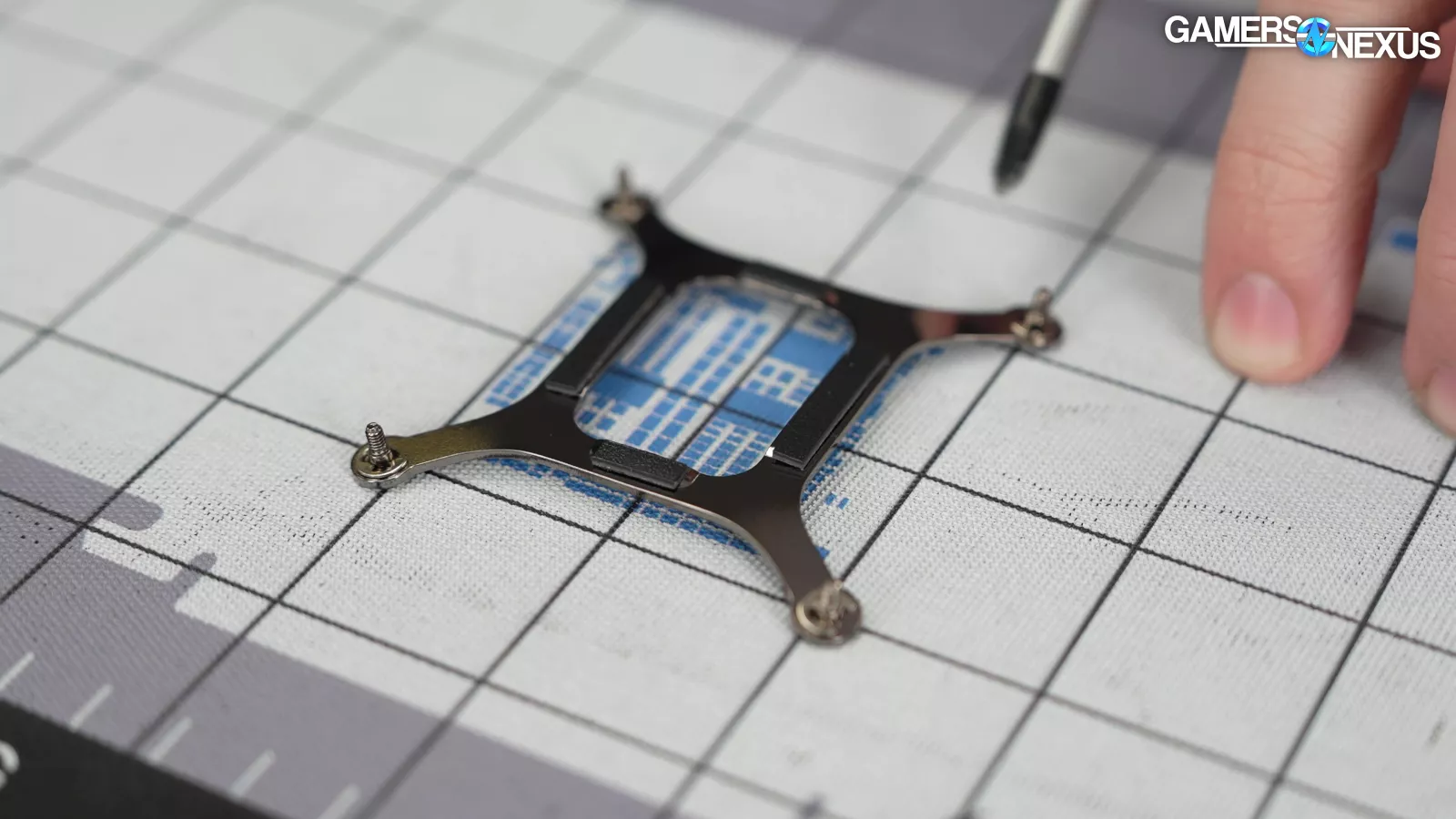
The leaf spring is a standard design. It also has isolating pads on it and captive screws in the corner.
Removing the cooler from the card, the contact patch looks to use a phase-change pad. The memory uses 3 pads, which are on the nickel-plated copper cold plate. This means the GPU and memory use the same cold plate.
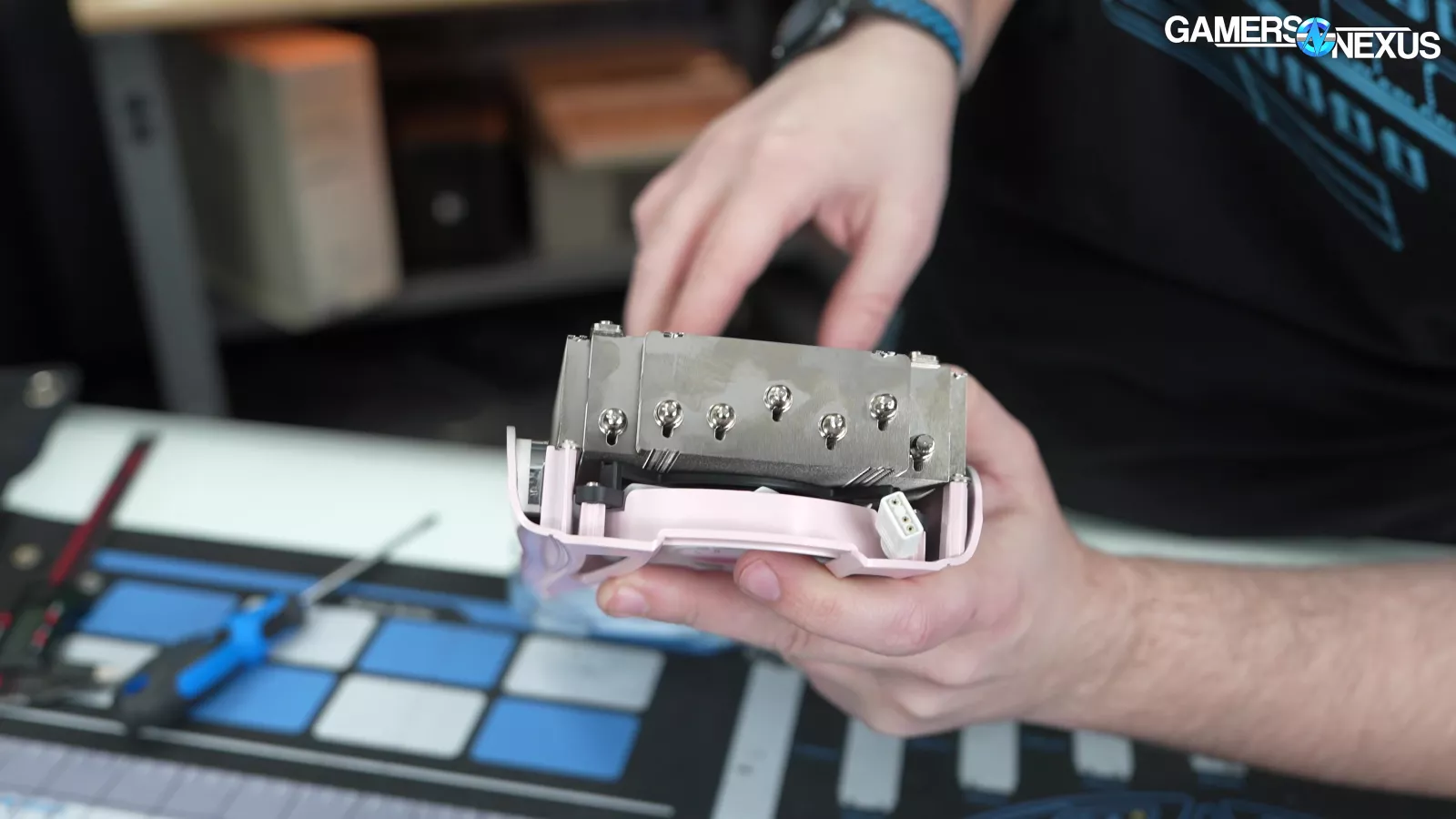
The card uses 7 heat pipes, which go through the entirety of the card.
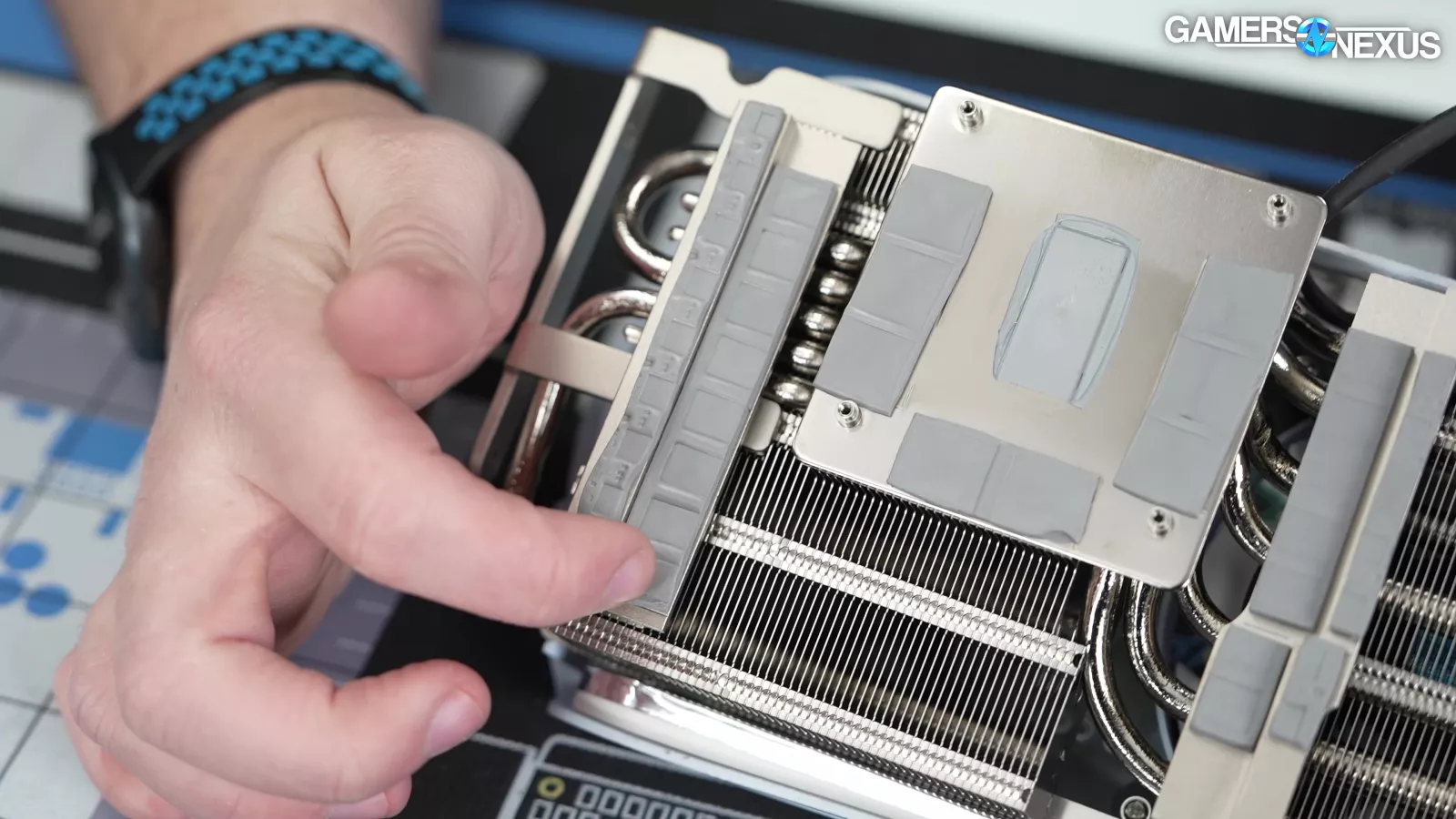
The card also employs thermal pads for VRM and MOSFET cooling in the image above.
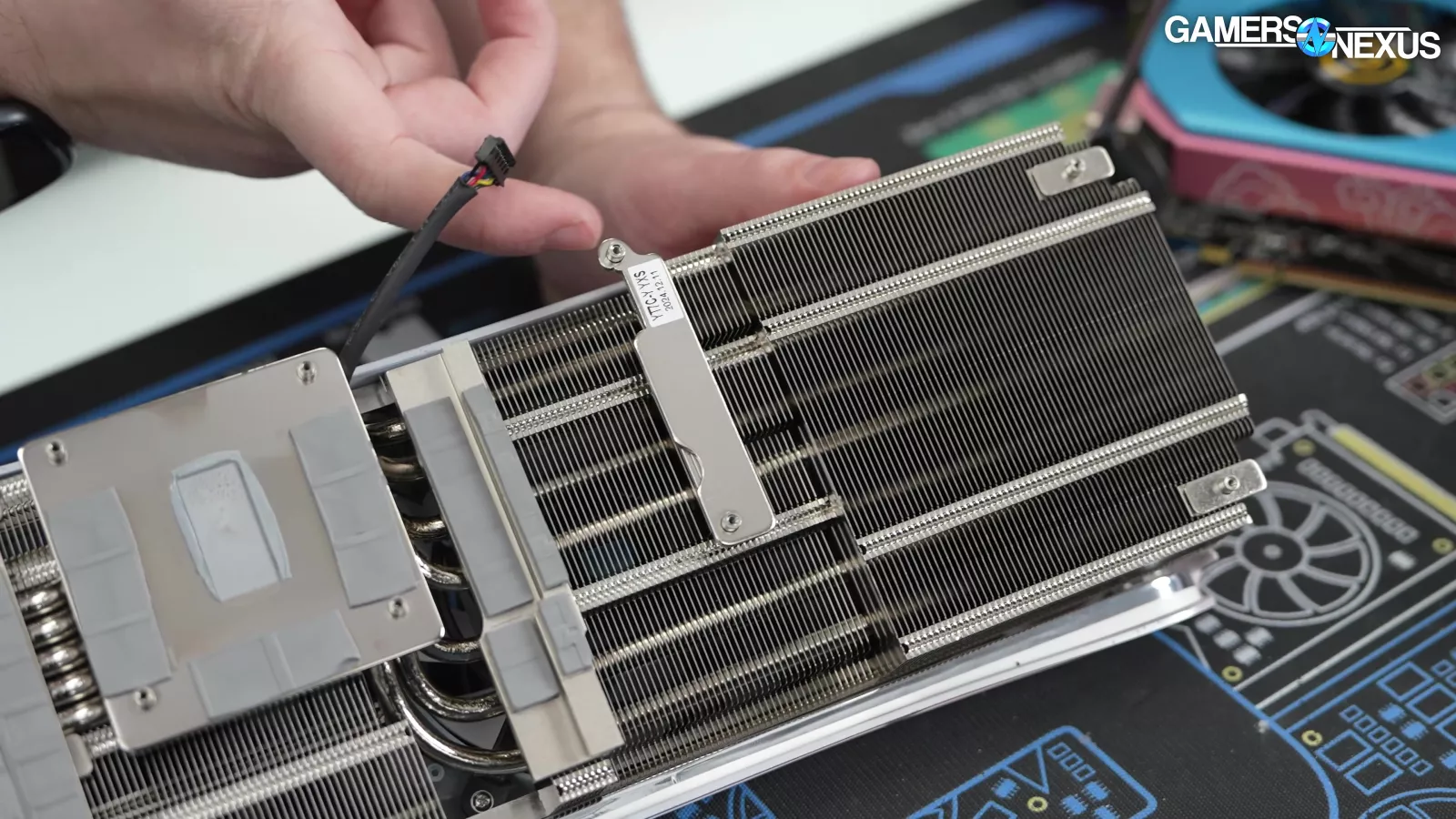
There’s also a little plate near the center here, which looks like it was designed for stabilization.
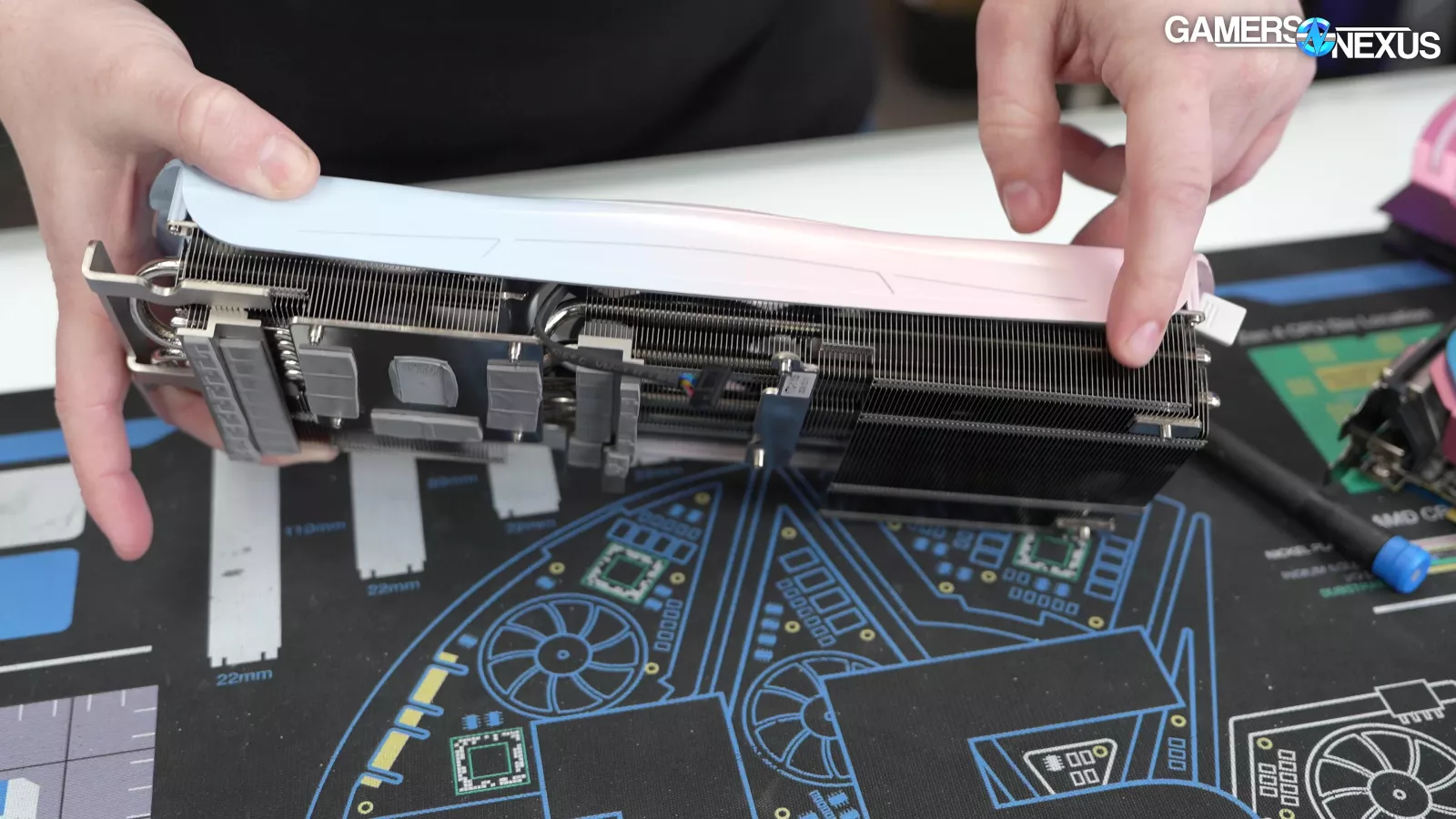
The card has as thick of a fin area as it can get, particularly for the flow-through area.
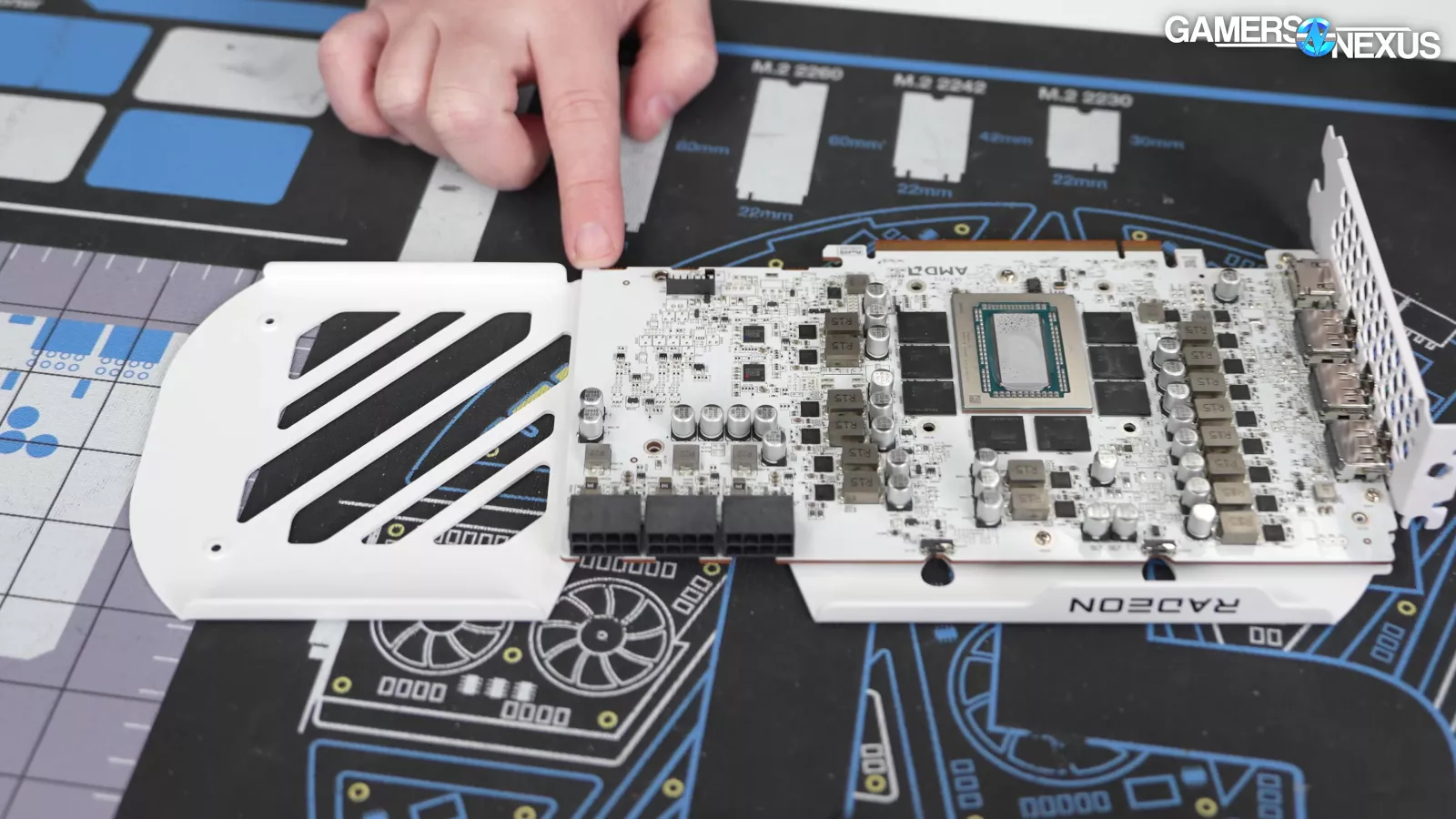
Looking at the PCB, the company has really good attention to detail on the white board, which matches the white back plate, and compliments the light-colored shroud on the front well. The color matching is cool to see.
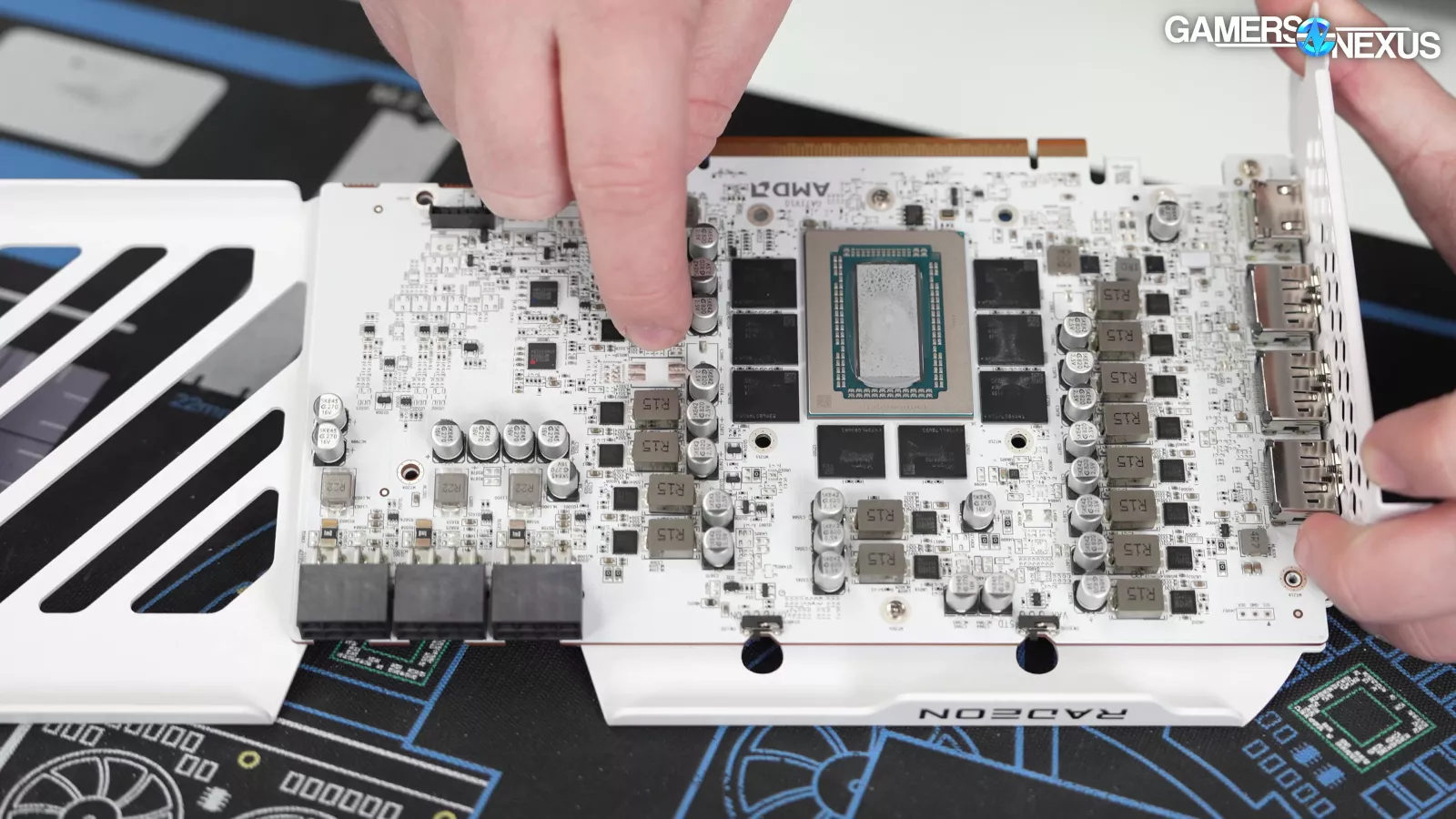
In terms of the design of the PCB, the company has got room for extra phases.
Moving forward with the tear down, we removed some screws to remove the PCB from its back plate. Doing so exposes some very beige thermal pads on the back plate, which measure roughly 2-2.5 millimeters. It’s good that Yeston is taking advantage of the metal on the back plate with the thermal pads here, as it helps cool down the memory modules.
To release the shroud from the fin stack, we had to remove 4 screws. One of the screws featured a cut-out to accommodate a screw driver, which is a nice design.
The shroud has a pretty large PCB for the LEDs. We also noticed a foil inside, which we presume is to help reflect some of that light to try and get things looking brighter. Everything is routed through one cable. Each of the 3 fans is mounted with 4 screws, which is pretty standard.
This shroud area is where we also found the scent module. We asked for opinions of the scent around the office and got several opinions which ranged from it smelling like: a car freshener, a free sample kiosk at a mall, fabric softener, and a Glade plugin.
We don't know what the scent module is made of. It feels like it’s made of plastic and we’re not sure how Yeston is implementing its smell.
Equilibrium Thermals, Noise, and Power
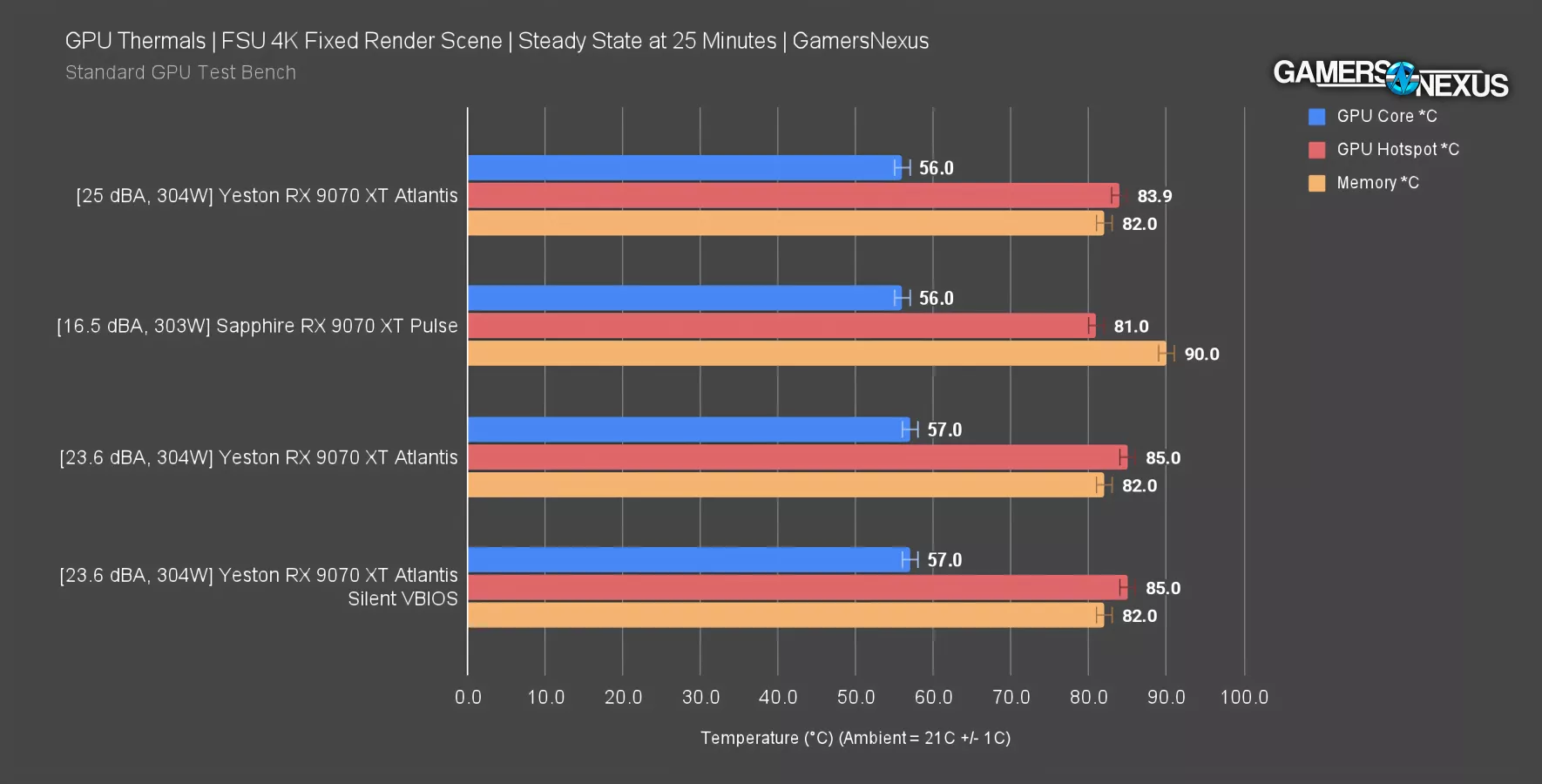
This plot of temperature at equilibrium compares the Yeston card against the Sapphire Pulse XT that we already reviewed and recently did a tear down on. We’ll keep adding to this.
So far, the two cards are hitting the same GPU edge temperature at 56 degrees Celsius when in a controlled ambient of +/- 1* C from 21 C. The coolers achieve the same performance on the GPU core. Hot spot temperature is relatively high on both, but not yet untenable on the Yeston card: It’s at 85 degrees when left to run at its auto settings, or 84 with our noise-normalized target that we’re beginning to collect data for. We haven’t run the Pulse XT at this target yet.
The memory temperature is the real differentiator: The Yeston card held an 82-degree memory temperature result, which is acceptable. The Sapphire Pulse XT is running too quietly for its own good here, hitting 90 degrees Celsius on memory in open air. In a hotter case, this will become a problem. We think the Pulse should ramp its fan speeds more. They’re the same for core, but the Yeston card has a significant memory advantage.
Both cards are at the same power level, so noise remains a key differentiator.
As for the Silent VBIOS on the Yeston card, its fan speed was identical and the test results were identical. We could not find a real change between the two VBIOS options.
Thermals vs. Fan RPM
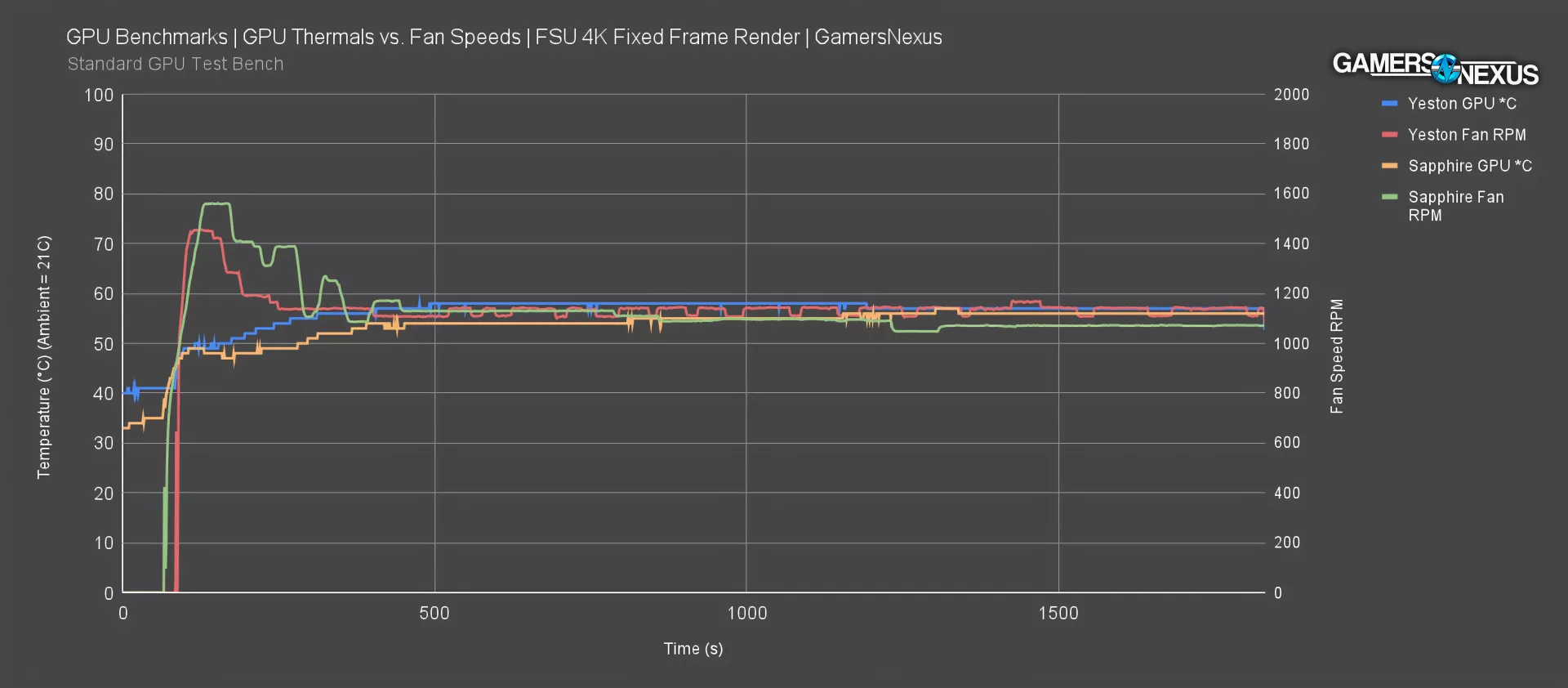
This plot shows thermals over time to better understand the fan ramp and hysteresis.
The Yeston GPU ramped to about 50 degrees initially, kicking on the fan to 1,450 RPM and holding temporarily. This briefly stalled the temperature climb, but then the temperature continued ramping -- which is expected behavior until it hits steady state -- and weirdly, fan speed dropped massively after this. It fell from 1,450 RPM to around 1,100-1,160 RPM. We’ve seen this behavior on AMD cards in the past. This behavior is controlled mostly by VBIOS.
Plotting the Sapphire GPU, it oddly exhibited similar, but more exaggerated behavior: The Pulse XT initially aggressively ramped its fans to 1,560 RPM, then dropped them to 1,400, then dipped to 1,330, then back up to 1,400, then down to 1,130 RPM, then back up to 1,250 RPM, then down to settle at 1,096 RPM until it settled even lower at the end of the test at steady state. This erratic fan behavior is just plain bad: This kind of fan fluctuation is noticeable to a user. You’re more likely to notice a change in noise than a constant, louder noise, and this amount of change over a span of 10 minutes would be noticeable.
We’re not sure what it is in VBIOS or AMD’s drivers that would be causing this behavior, but it should be flattened and corrected.
Acoustic Frequency Spectrum
This next plot was taken in our hemi-anechoic chamber, which is useful not only for hiding from paper launches and fake MSRPs, but also for benchmarking components. Our chamber was a major investment in our test quality and accuracy and we’ve already gotten value out of all the time savings from it.
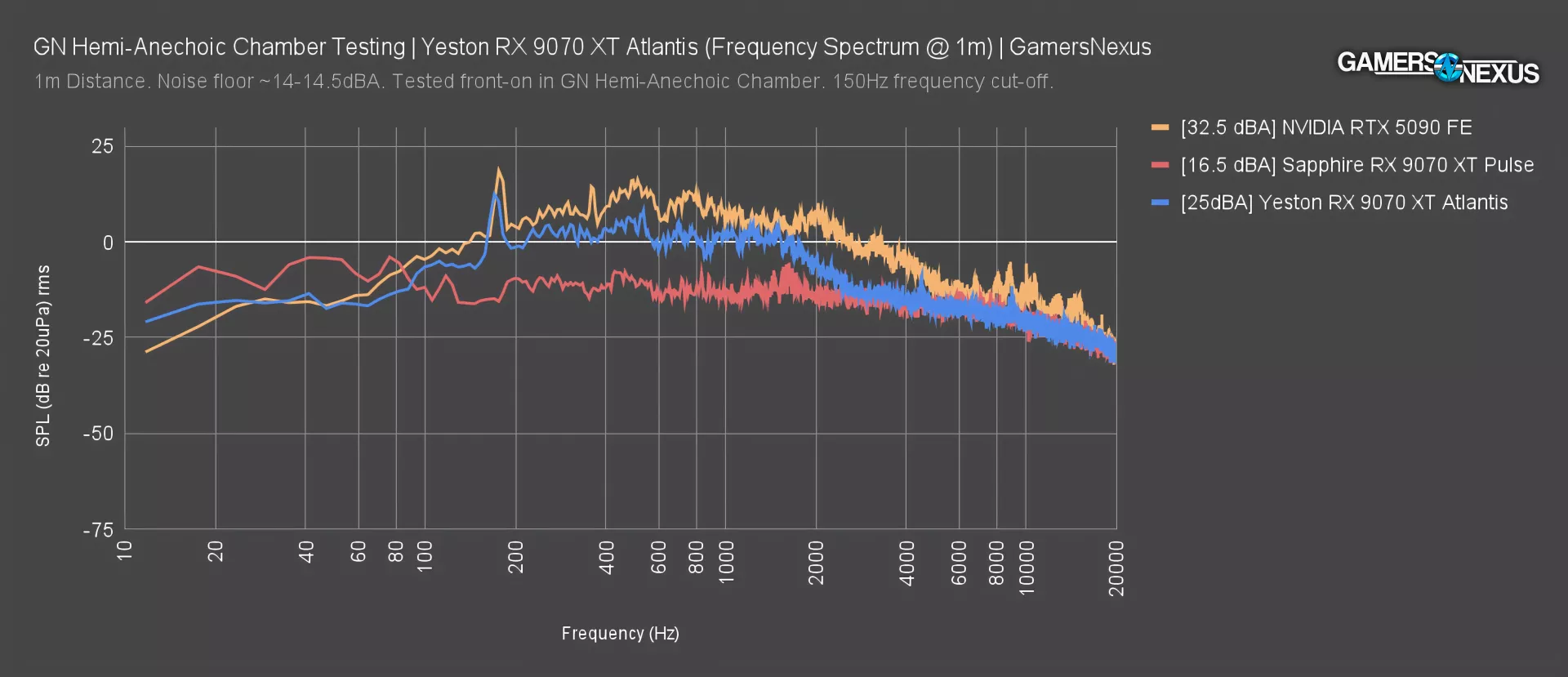
We’re looking at just the steady state fan speed here. Here’s the plot of the Yeston RX 9070 XT Atlantis card against the Sapphire Pulse that we reviewed. Both are shown represented by their fan speeds they ran during thermal benchmarking at steady state.
The Yeston 9070 XT has one spike at around 164 Hz, another small bump at around 400 to 515 Hz, then a gradual fall-off after that. Its frequency distribution is relatively typical. For reference, the 5090 -- which is louder -- is also plotted. You can see that the 9070 XT Atlantis follows the general trend of the 5090 FE (read our review), with the exception of the 5090’s spike around 2,000 Hz and 3,200 Hz.
The 9070 XT Pulse from Sapphire ran quieter than the Yeston 9070 XT Atlantis overall, which is also reflected in this incredibly flat frequency spectrum plot. We’re too close to the noise floor for good readings here. Once we buy our new microphone equipment, we’ll be able to drop the floor closer to 6 dBA. For now, the Pulse’s VBIOS temperature target results in a low noise level.
Yeston RX 9070 XT Gaming Benchmarks

We’ll quickly go over some gaming charts. There won’t be much meaningful change here, but that’s expected. Most of the benefit from these partner models is in so-called “quality of life” features, such as better cooling, better acoustics, extra VBIOS or LED switches, looks, and overclocking power headroom (but the silicon lottery itself is mostly the same between cards).
For that reason, we’ll keep it short. We’ve removed all cards from these charts except the 9070 series. For comparisons against NVIDIA and other AMD cards, check our review of the 9070 or 9070 XT.
Resident Evil 4 - 1440p

In Resident Evil 4 at 1440p, the 9070 XT Atlantis outperformed the 9070 XT Pulse on a pure technicality: We’re seeing about a 1 FPS advantage for the Yeston card.
Resident Evil 4 - 4K

At 4K, we saw a consistent result: It’s up at 103.6 FPS AVG against 102.9. That is well within variance and margin of error. You could get this kind of swing basically by restarting the test enough times. If you can notice this kind of improvement, you should probably sign up for a reflex research facility or something.
Starfield - 4K

It’s at least consistent: In Starfield at 4K, we saw the same behavior. The Yeston card is marginally faster in framerate. This isn’t a meaningful change, but it is becoming a pattern. The difference in lows is not meaningful. These are identical results.
Final Fantasy XIV - 4K

Final Fantasy at 4K has the two 9070 XTs we’ve tested as nearly perfectly identical. But of course, the most adept gamers among you will identify the 0.1 FPS AVG difference.
Cyberpunk 2077 PHL - 1080p RT Medium

In Cyberpunk 2077: Phantom Liberty at 1080p with RT Medium, we measured the Atlantis card as 0.3 FPS AVG higher than the Pulse XT. There’s no meaningful difference here.
We’ll call it there since this is clearly all the same.
Yeston RX 9070 XT Conclusion

Once again, Yeston has managed to make something that has some actual color theory to it, showing actual attempts at design. If its aesthetics aren’t your thing, we get it, but the company is doing things that are different. It’s taking risks and that’s great to see.
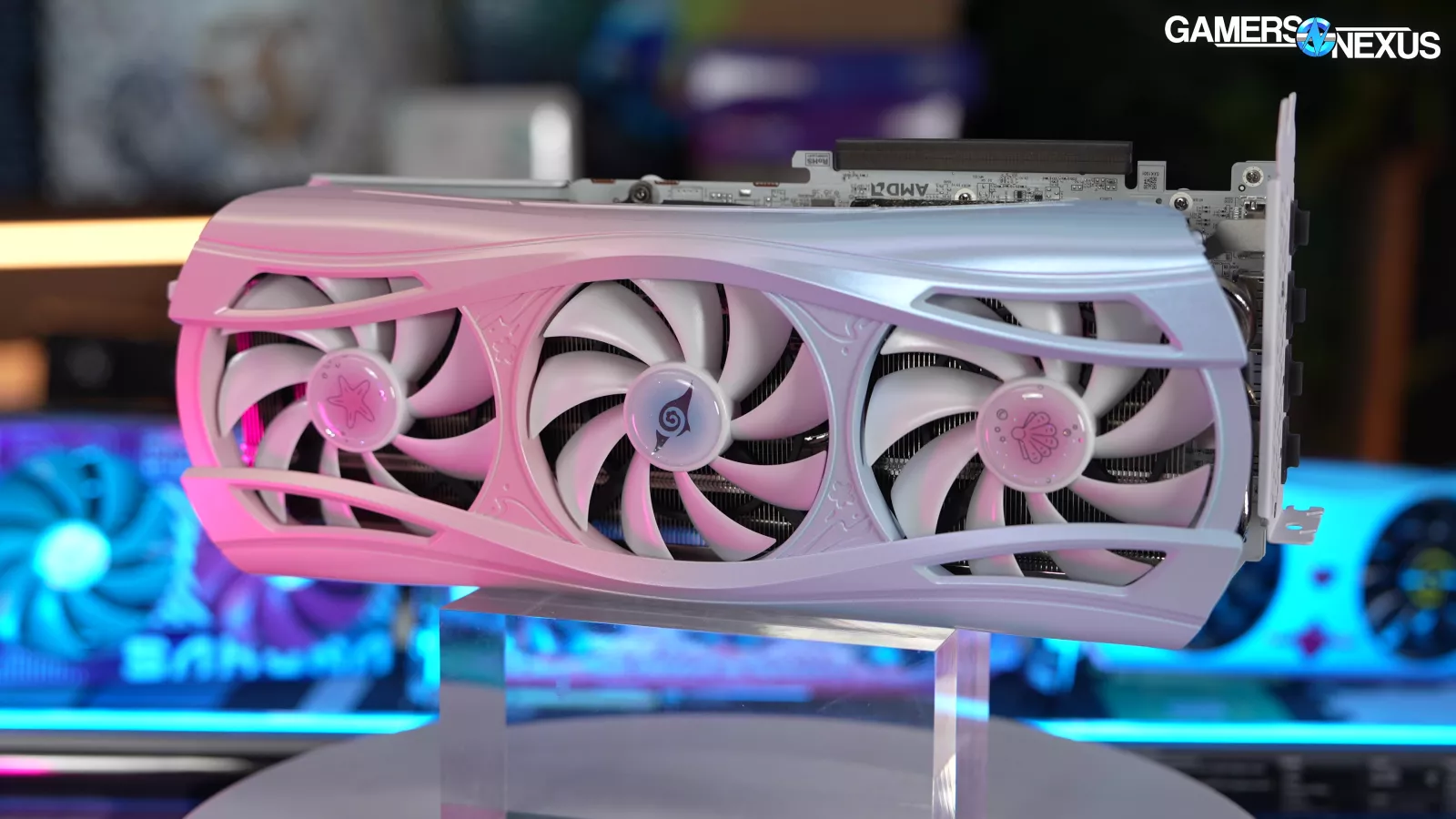
While Yeston looks like it uses meme/anime archetypes, they’re still designing things, that, in many cases, do pretty well. This particular card, however, does have middling thermal and acoustic performance. It is competitive with the Sapphire Pulse card and it manages its fan curve and RPM response much better. In addition, the Yeston card’s thermals are better.
In terms of overall performance, it’s fine. It achieves what it needs to achieve. If you like how it looks and are willing to pay whatever its street value is, then it’s fine as we found no major issues with it.
